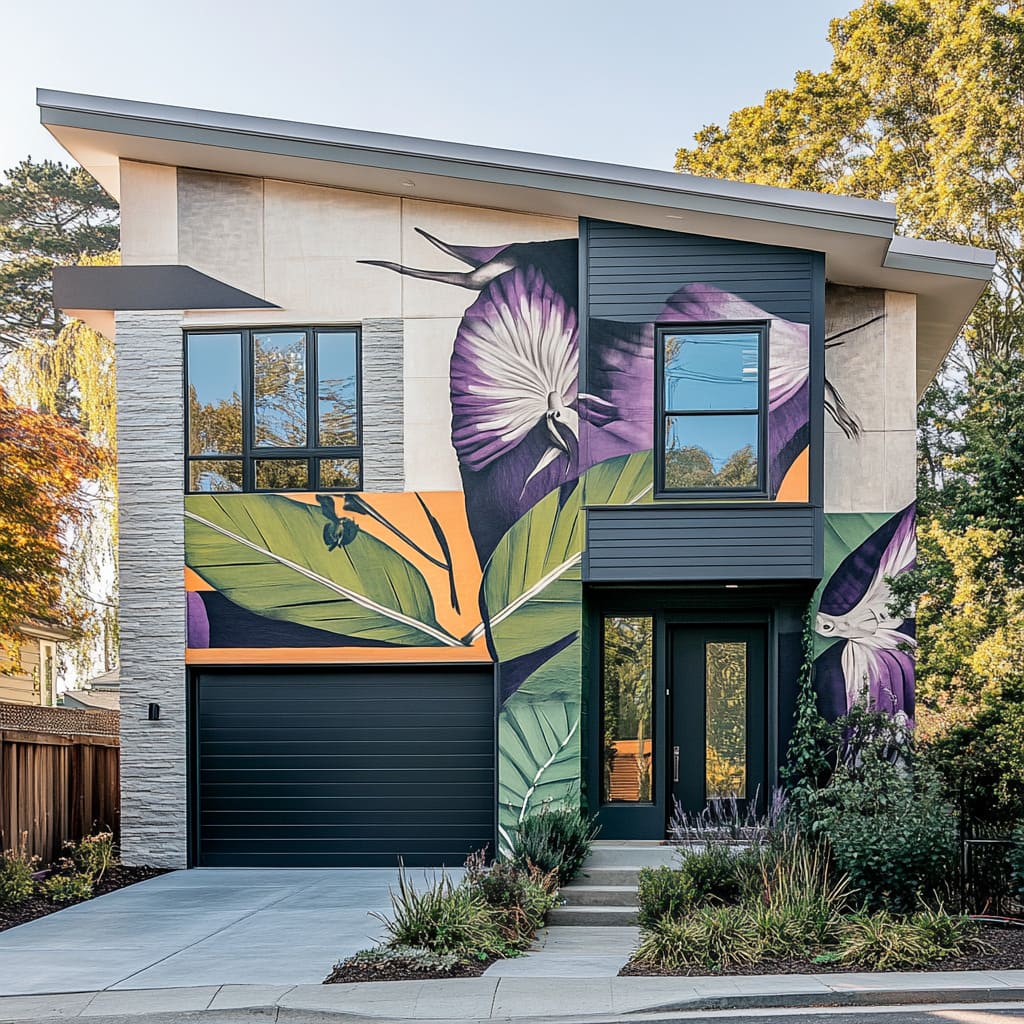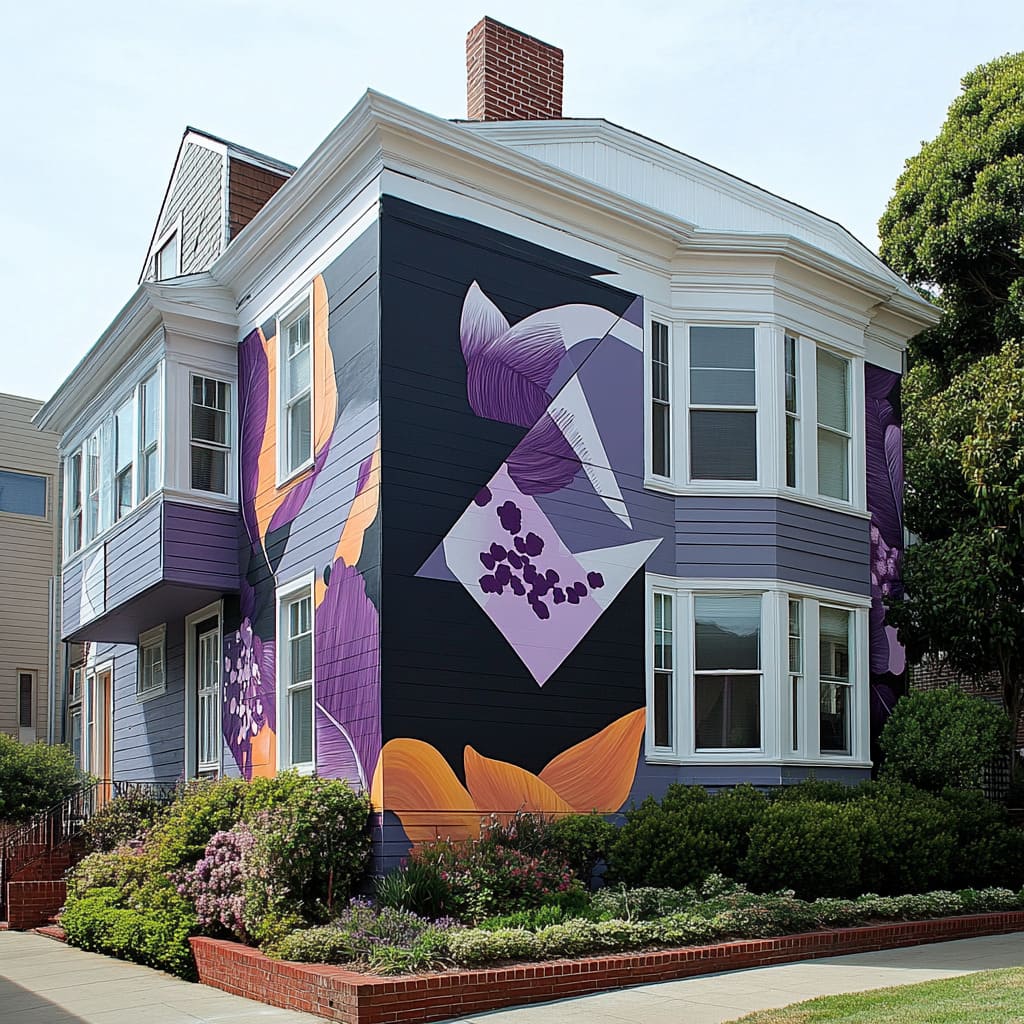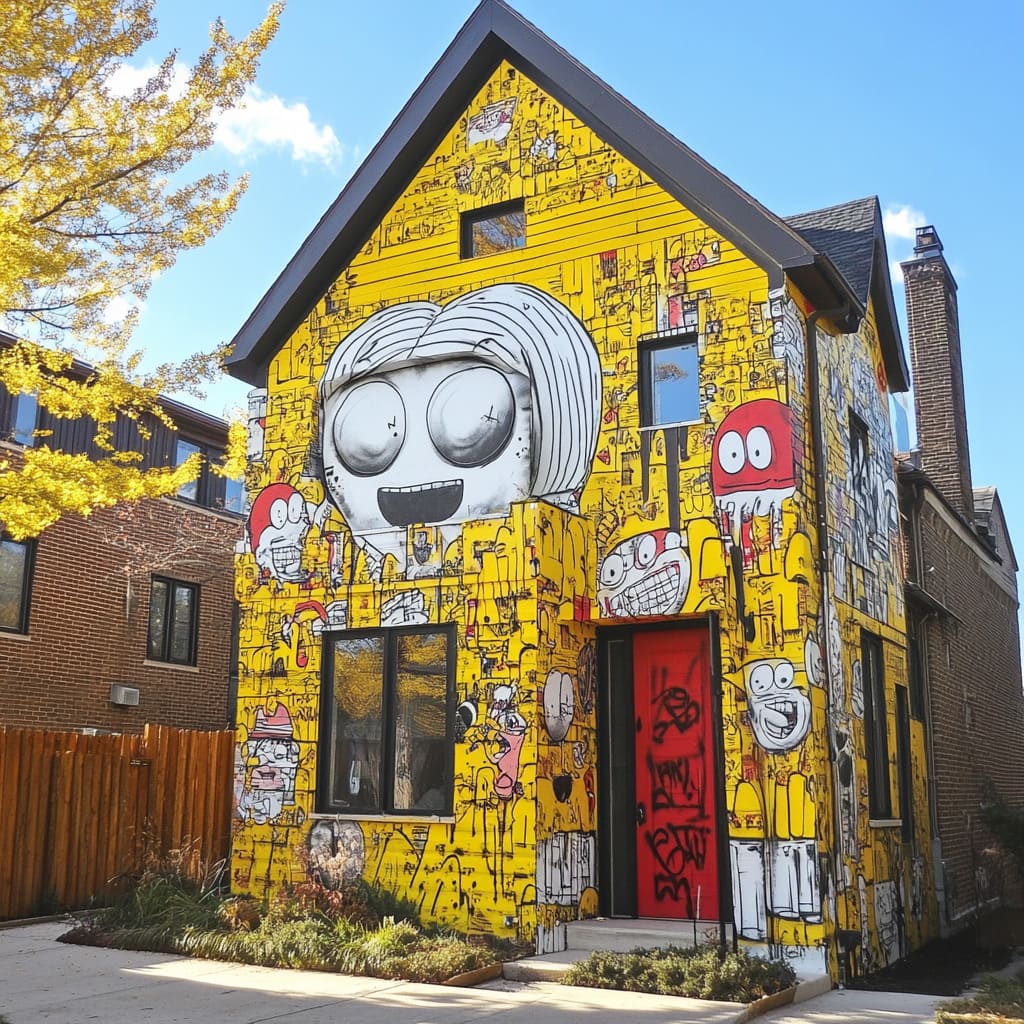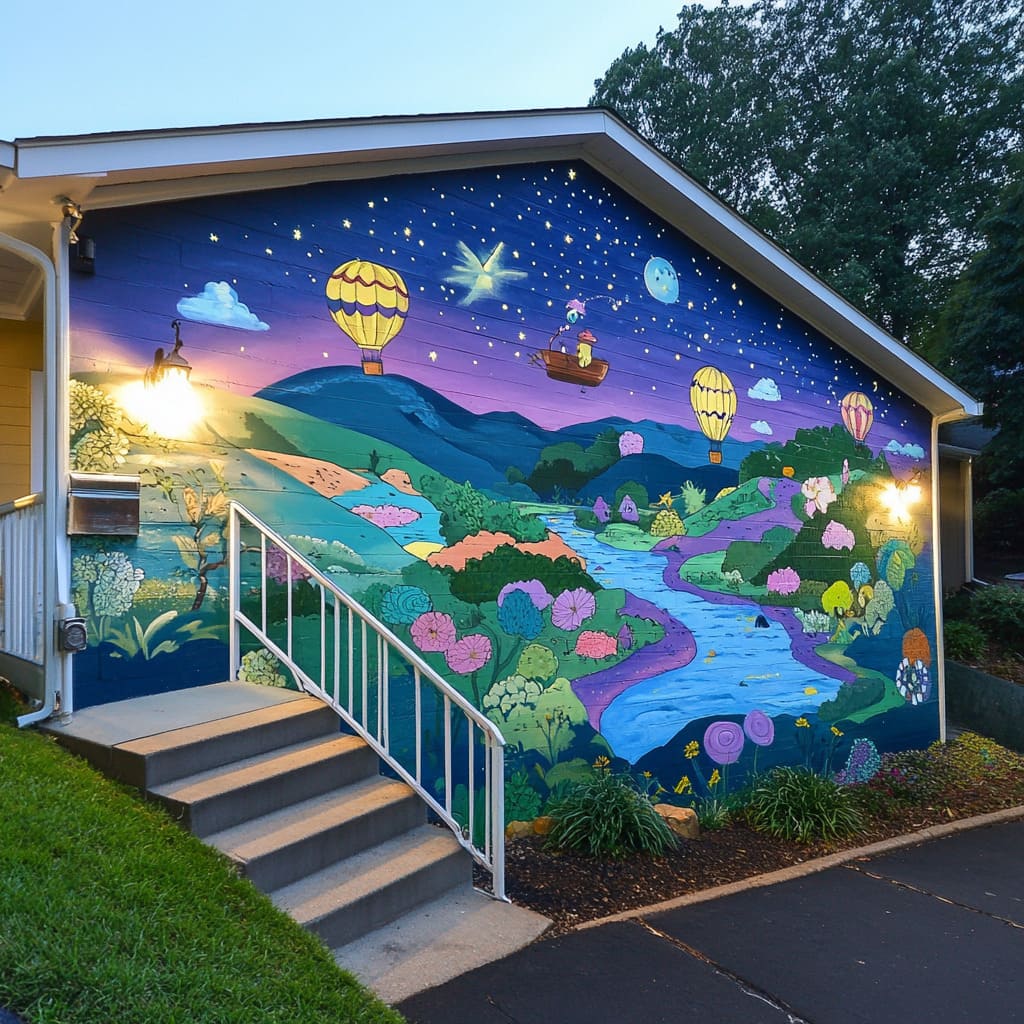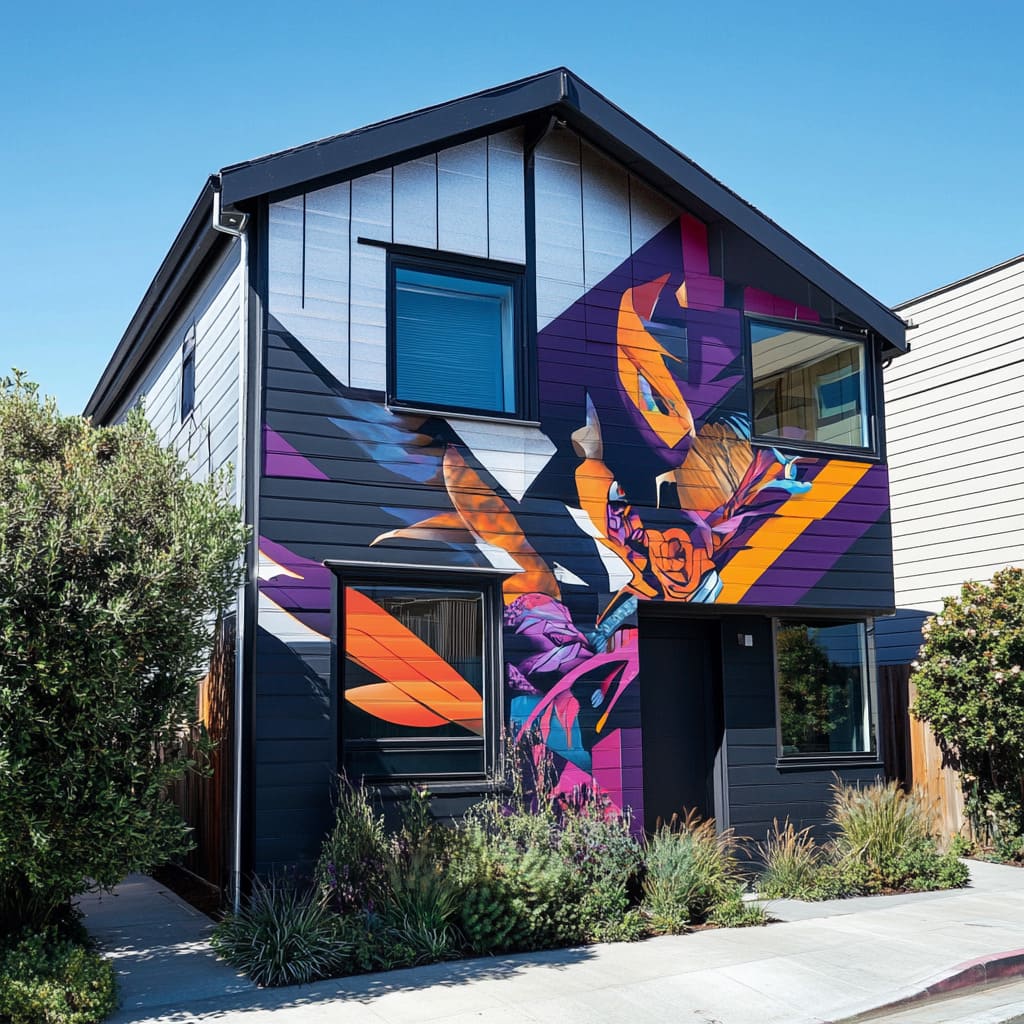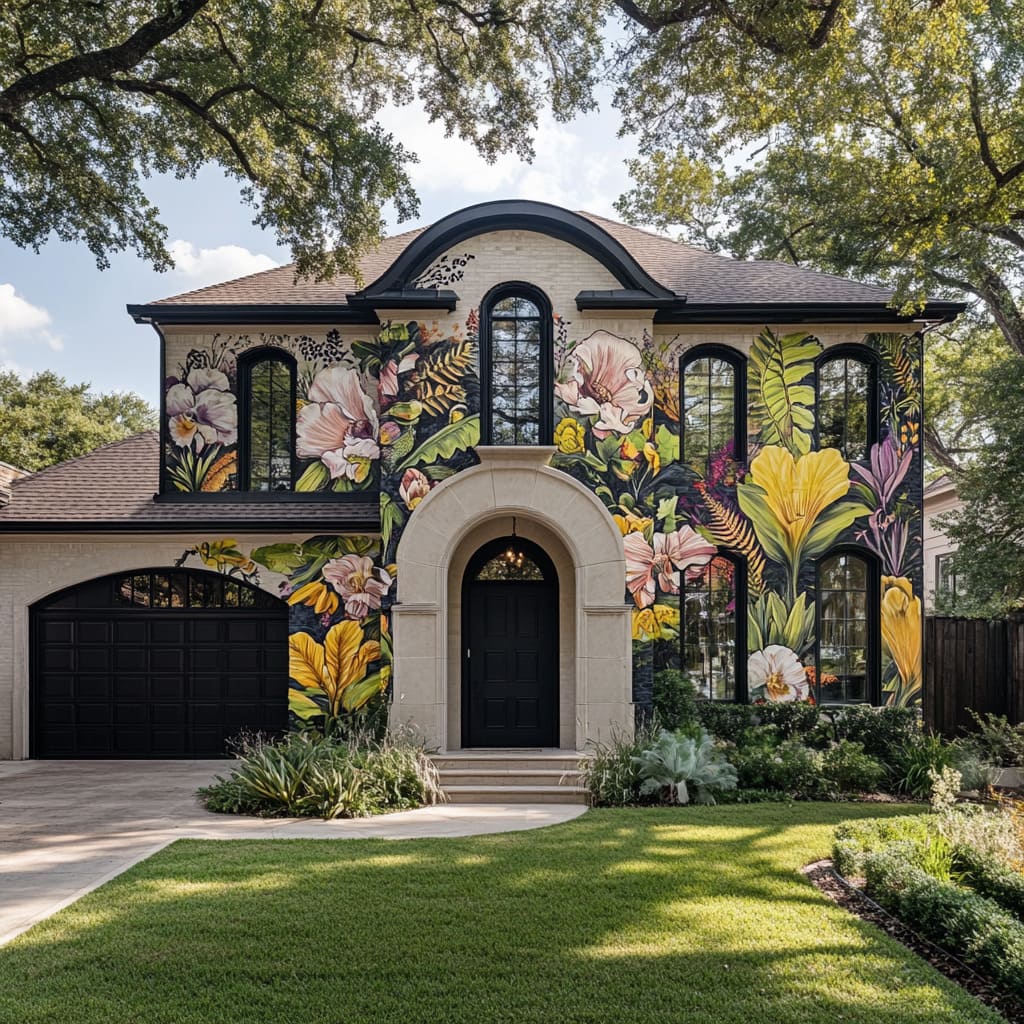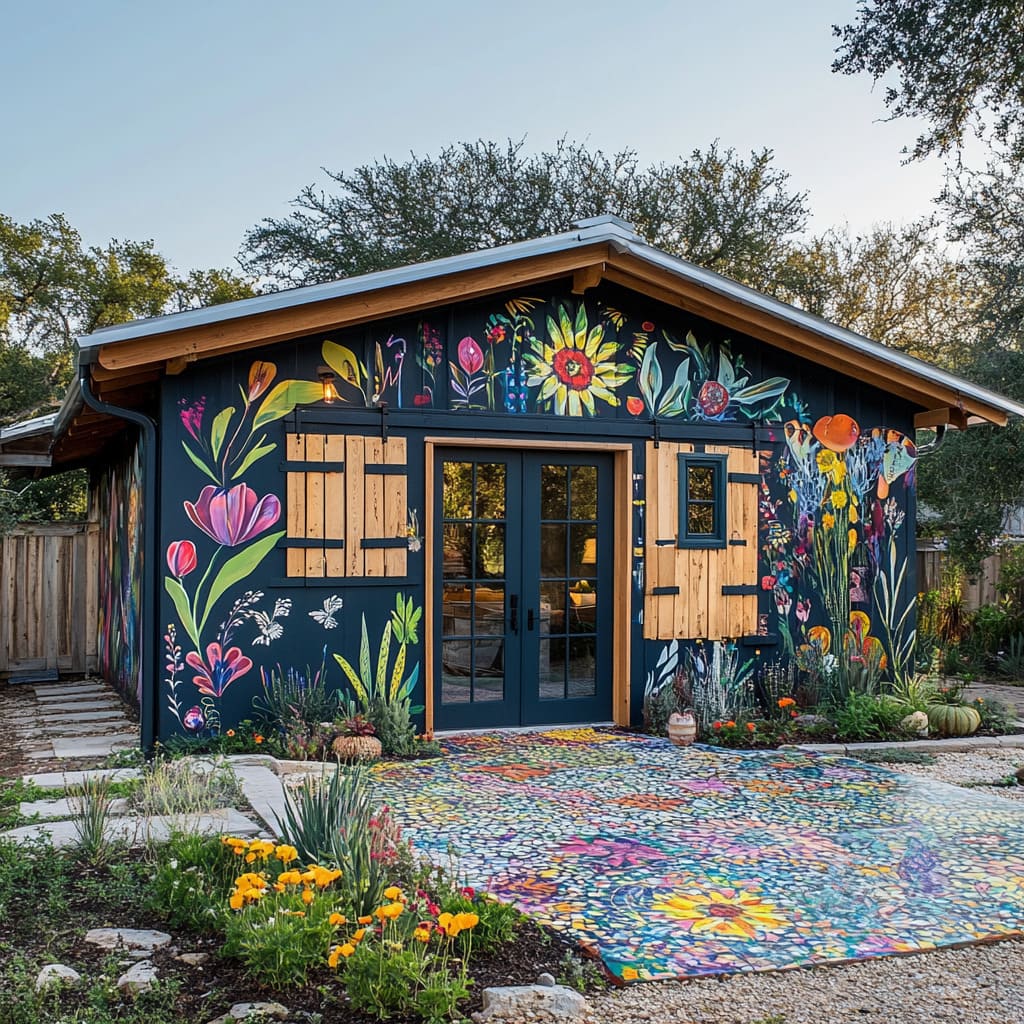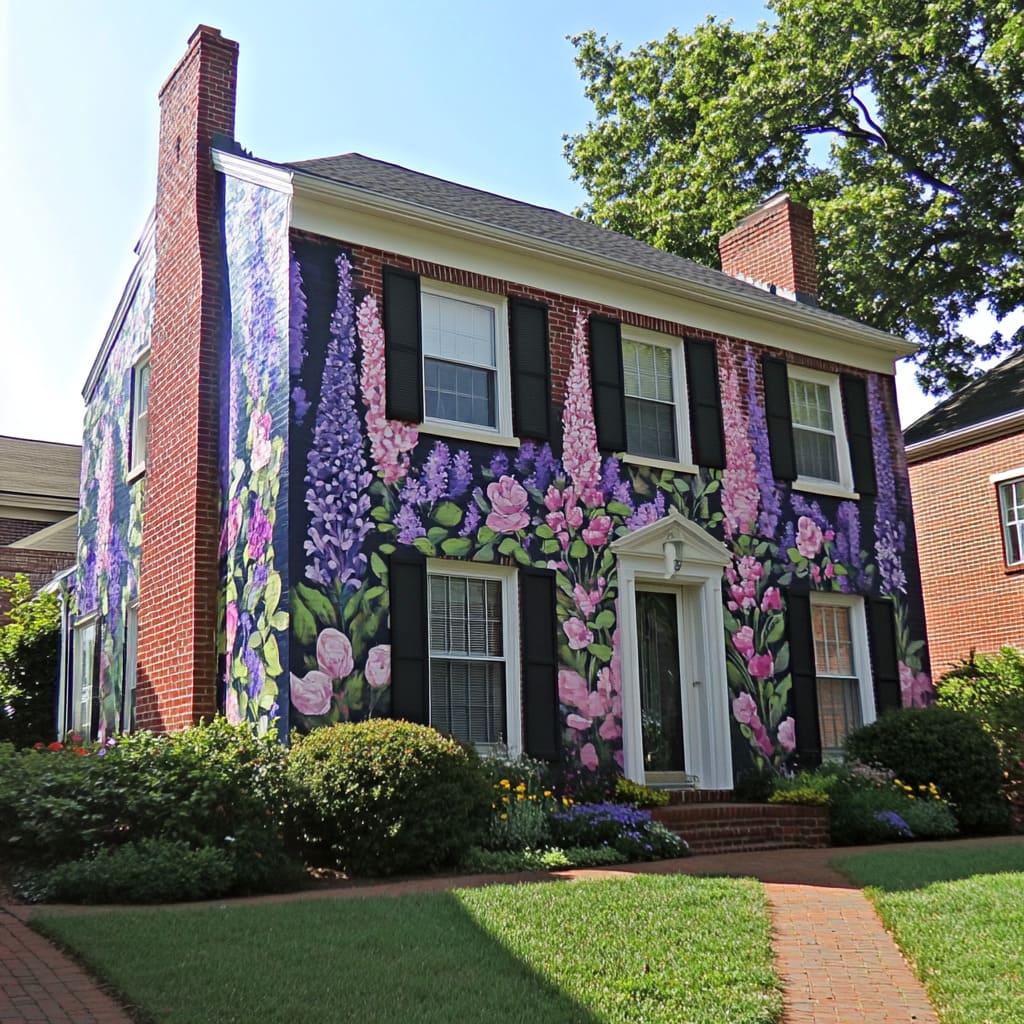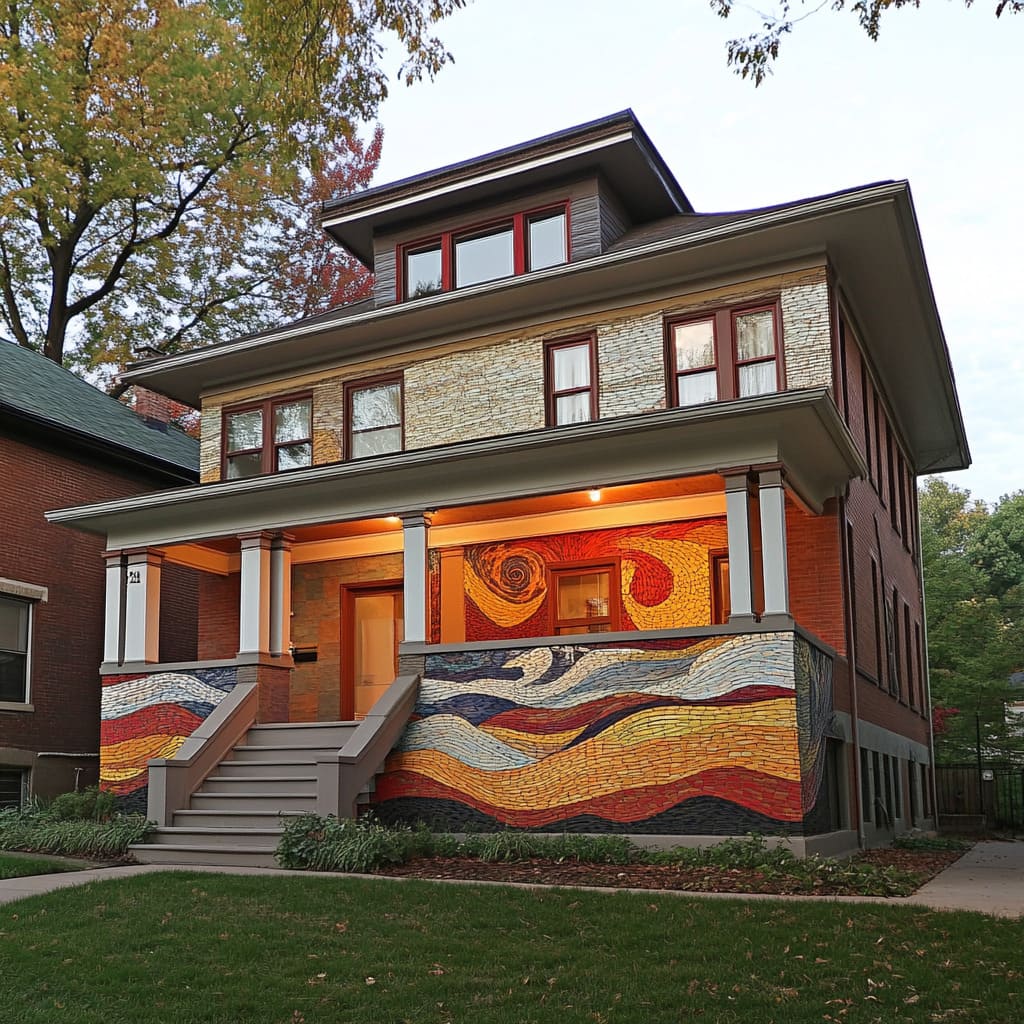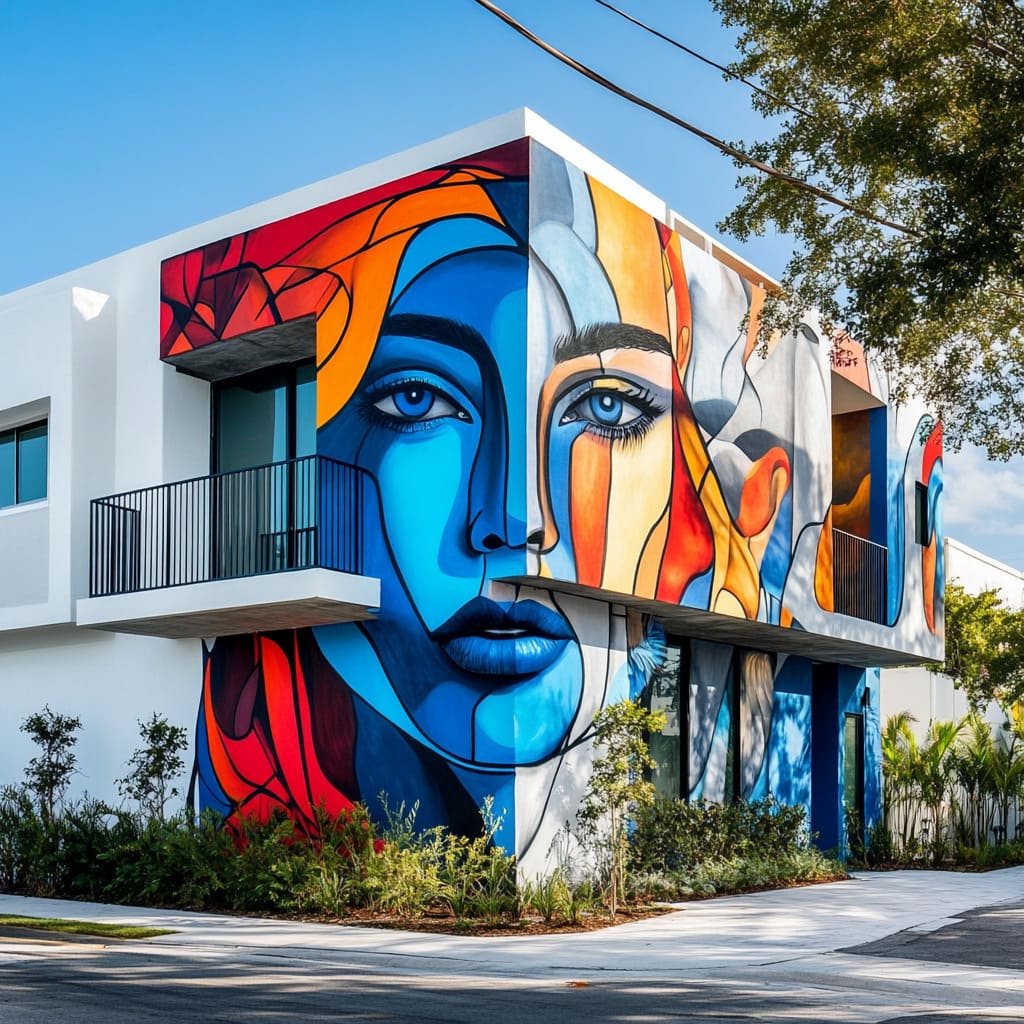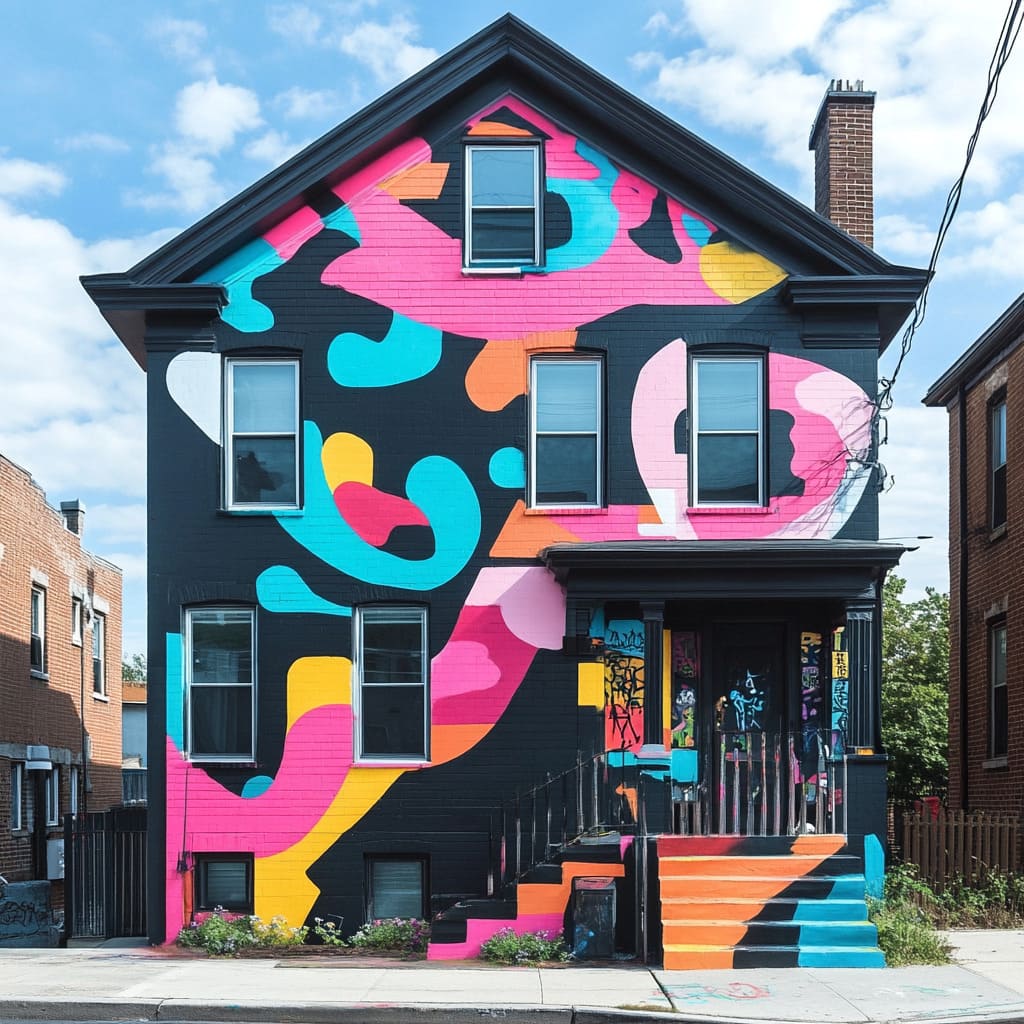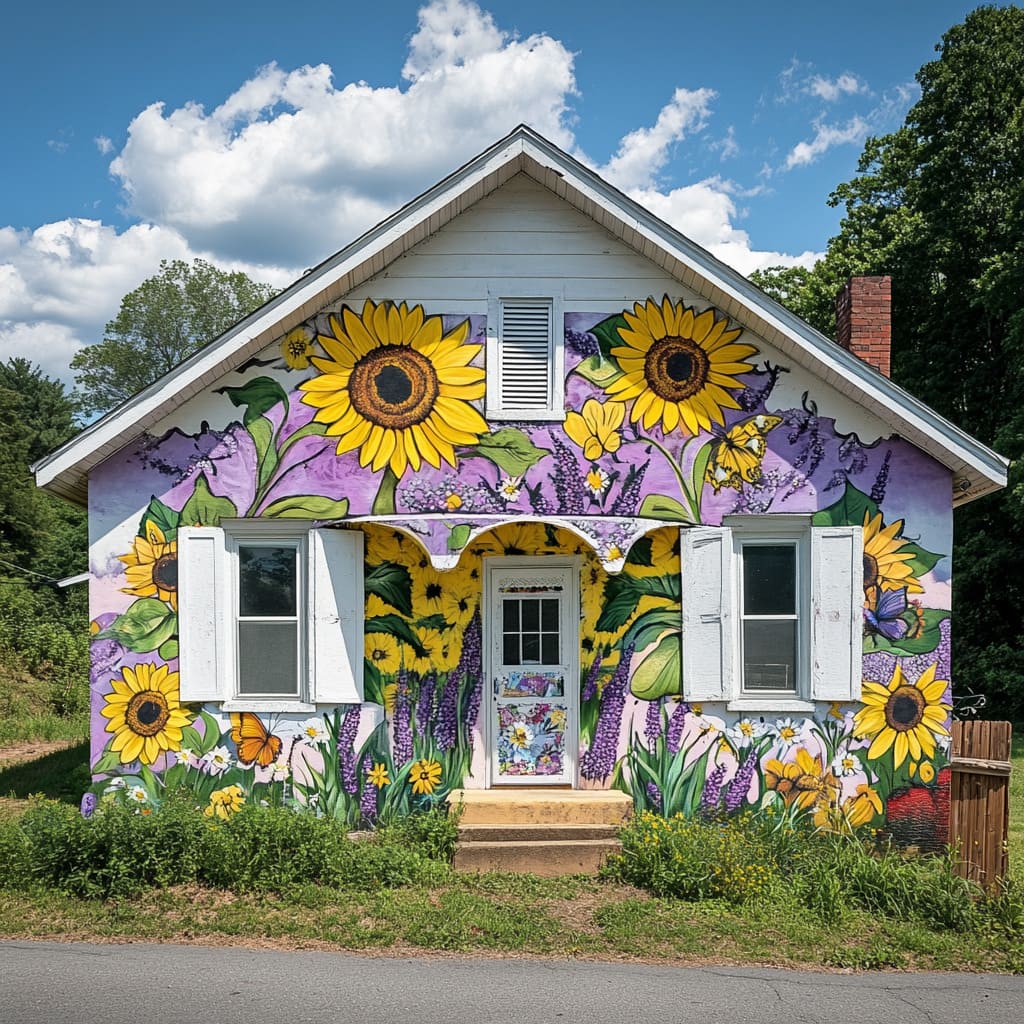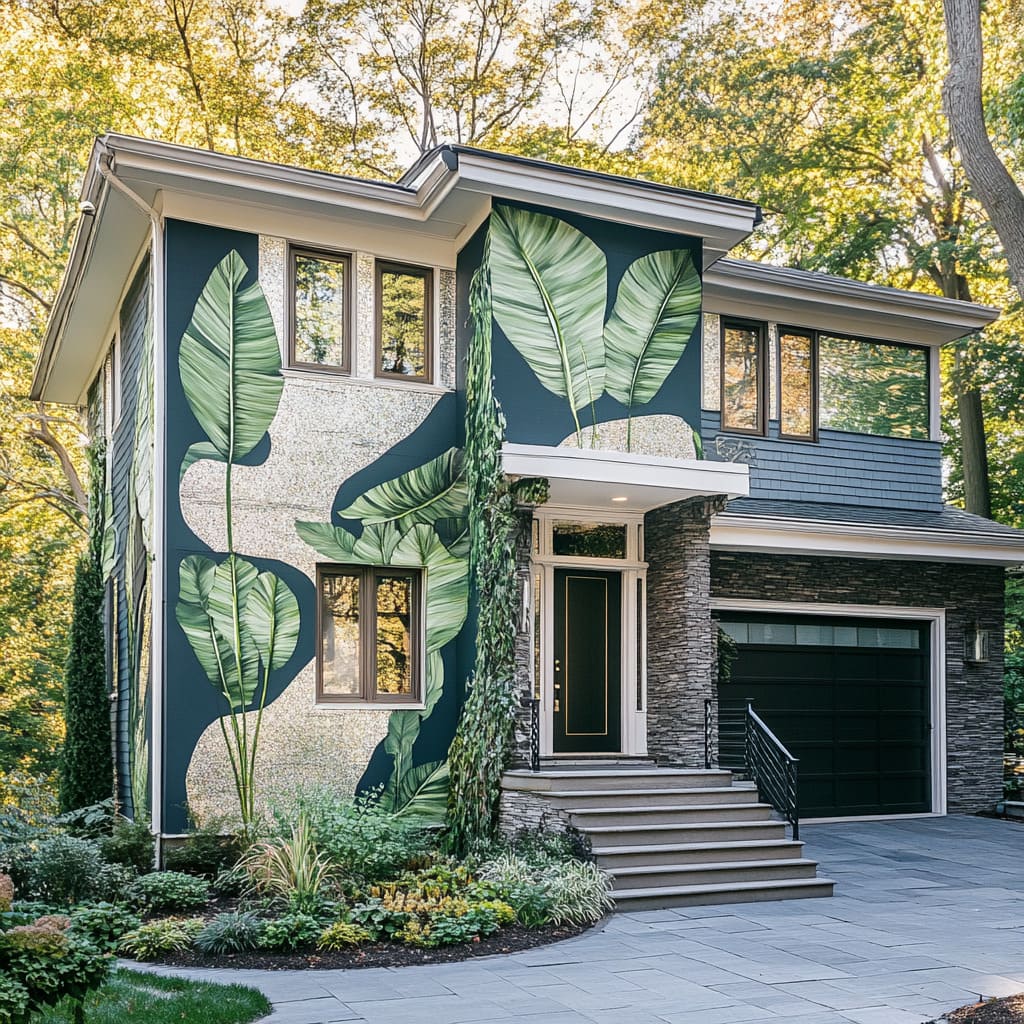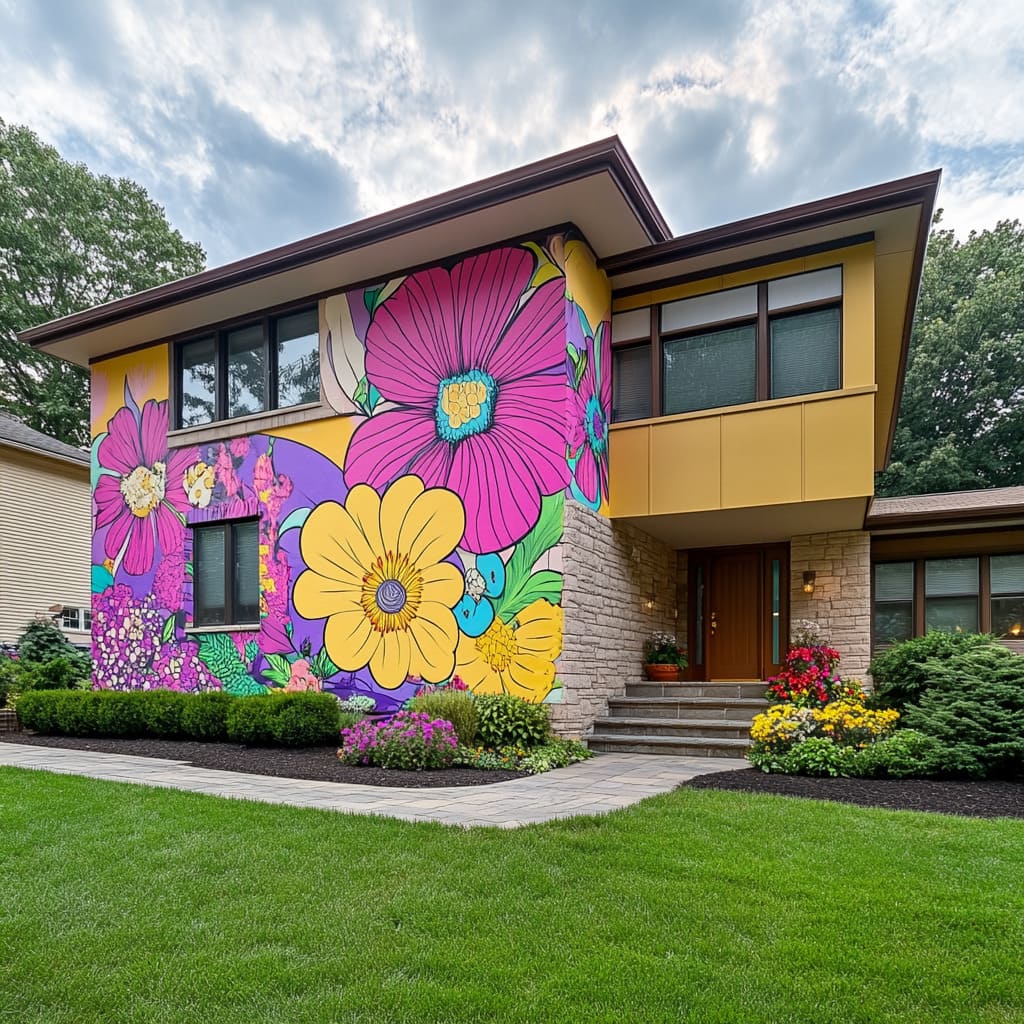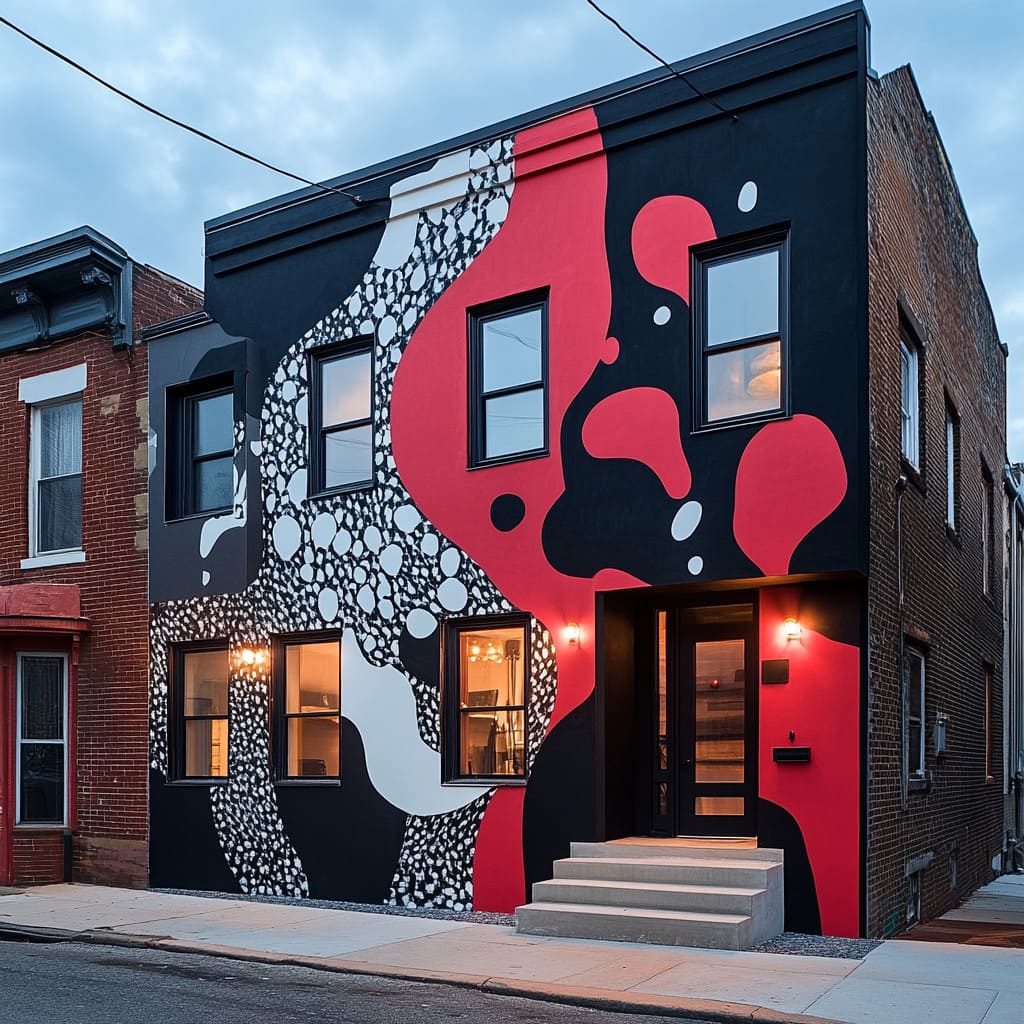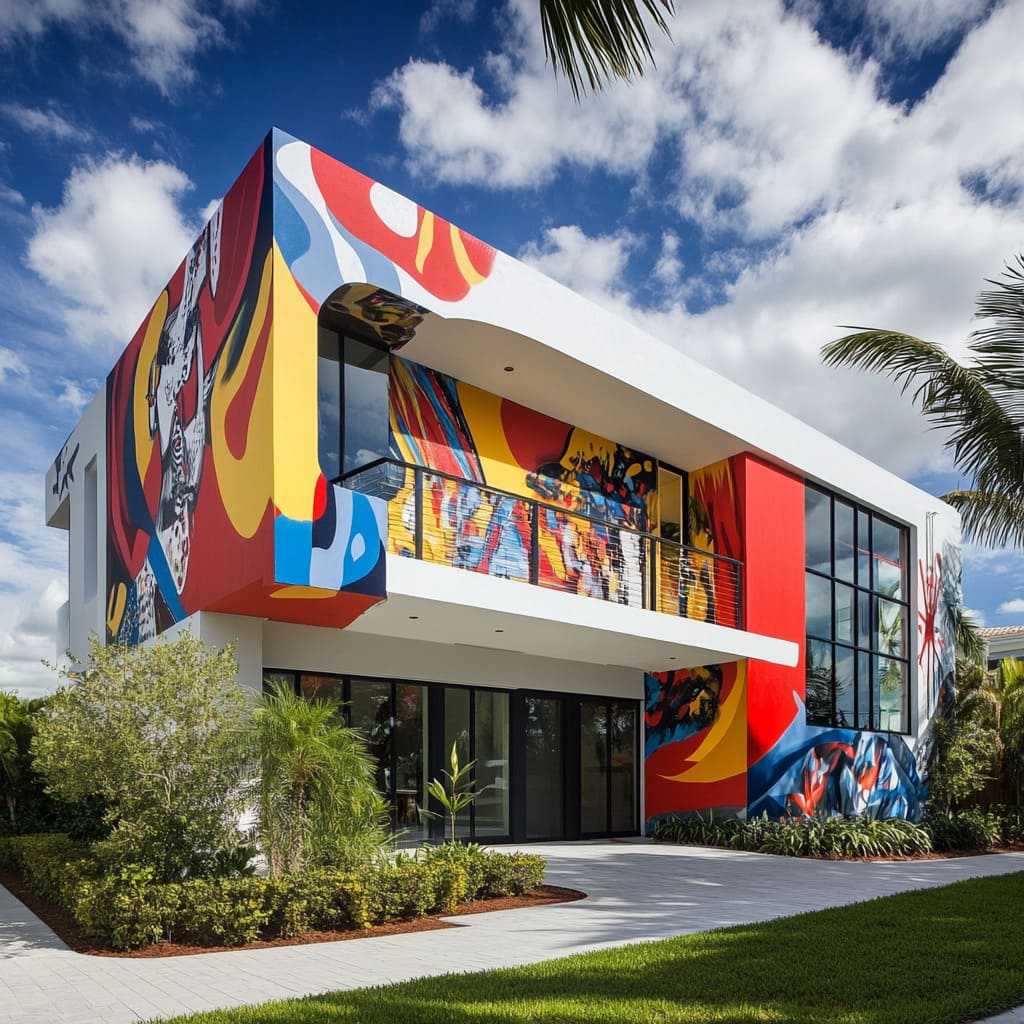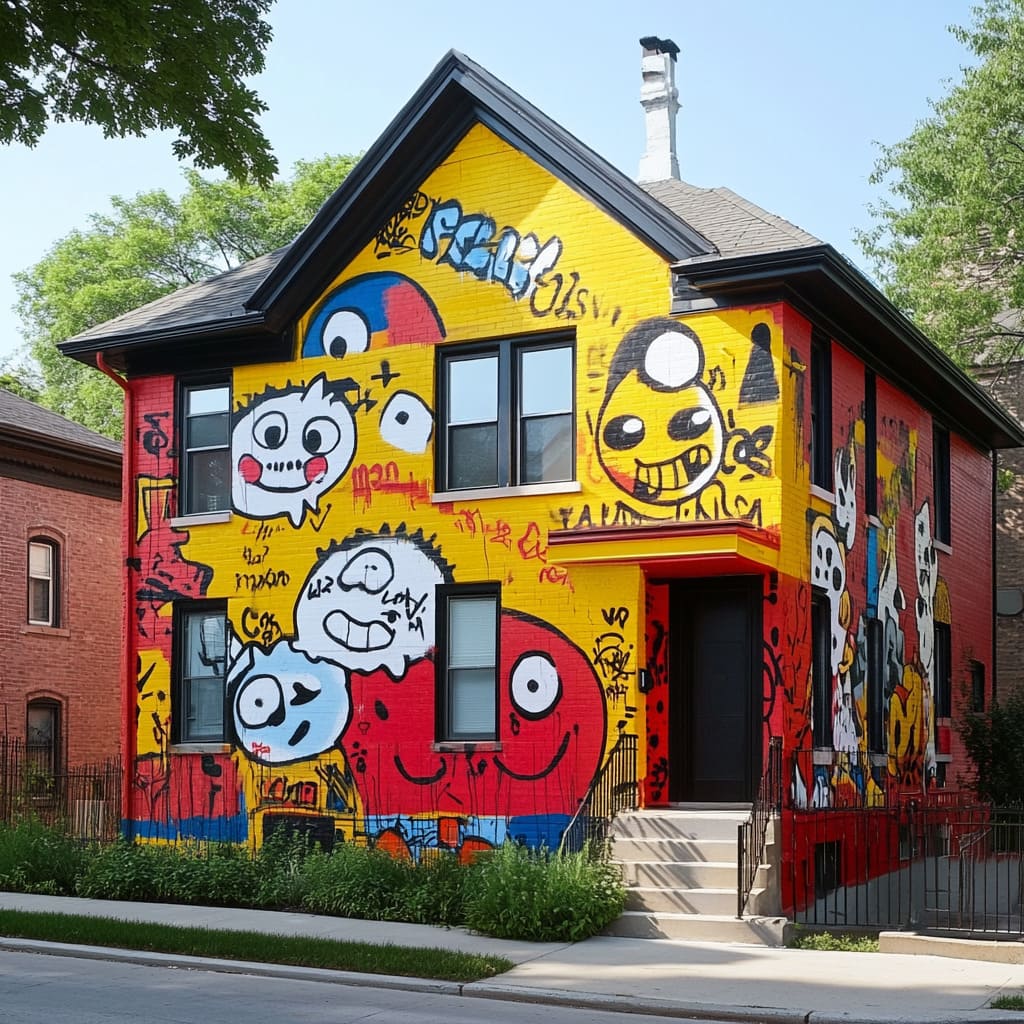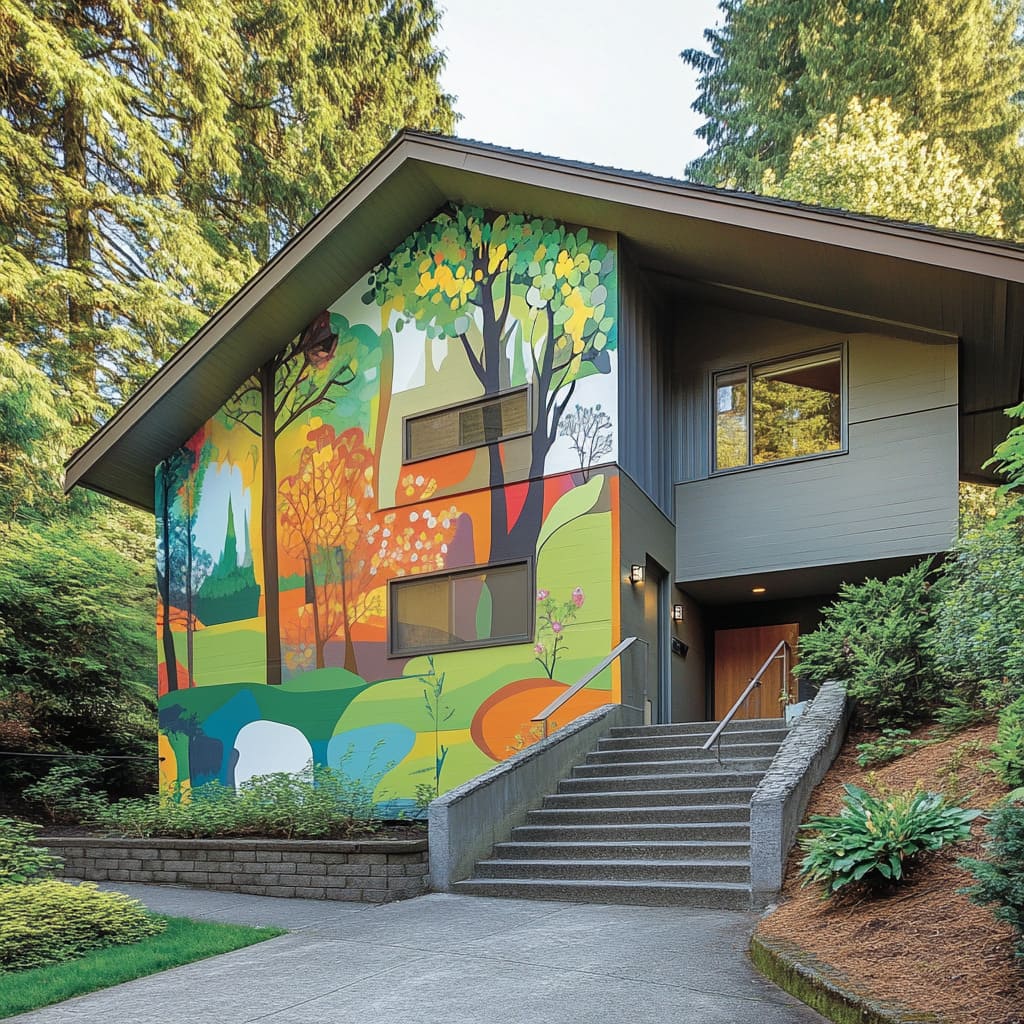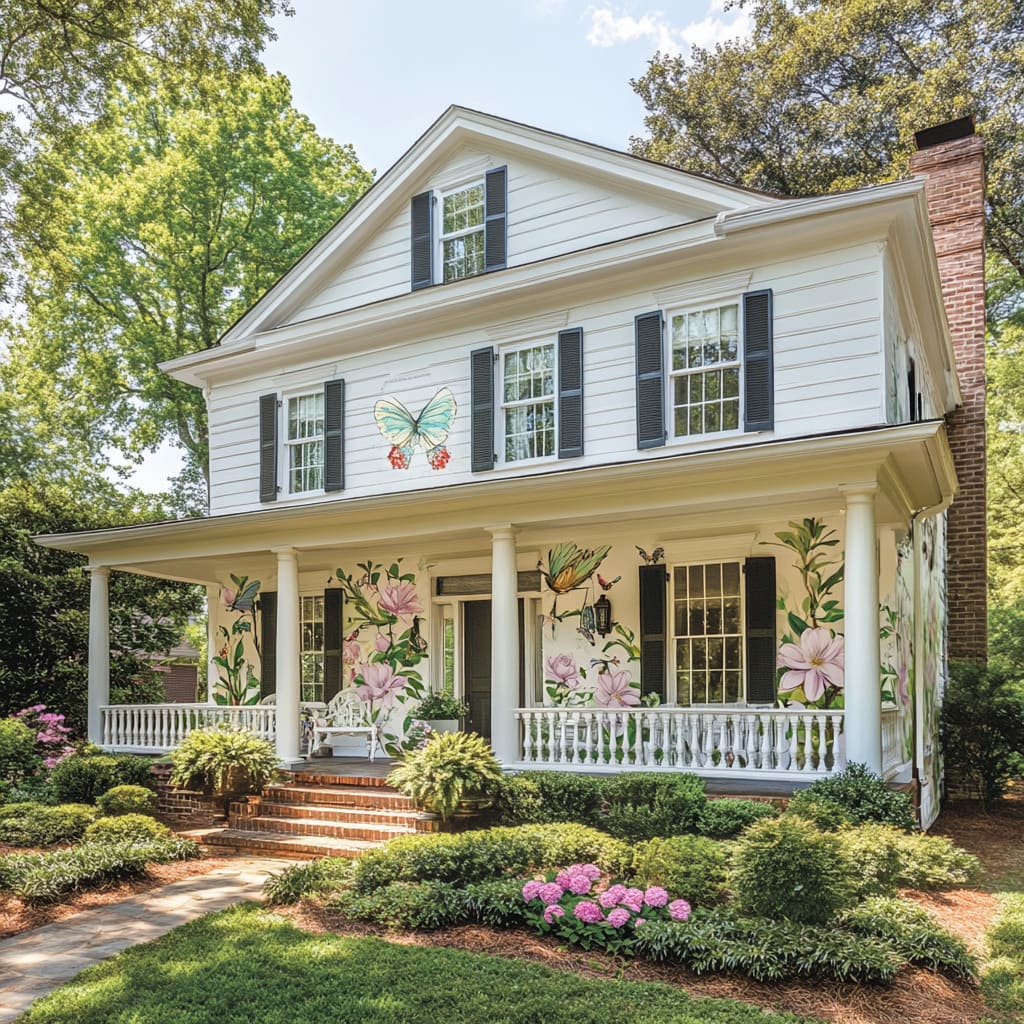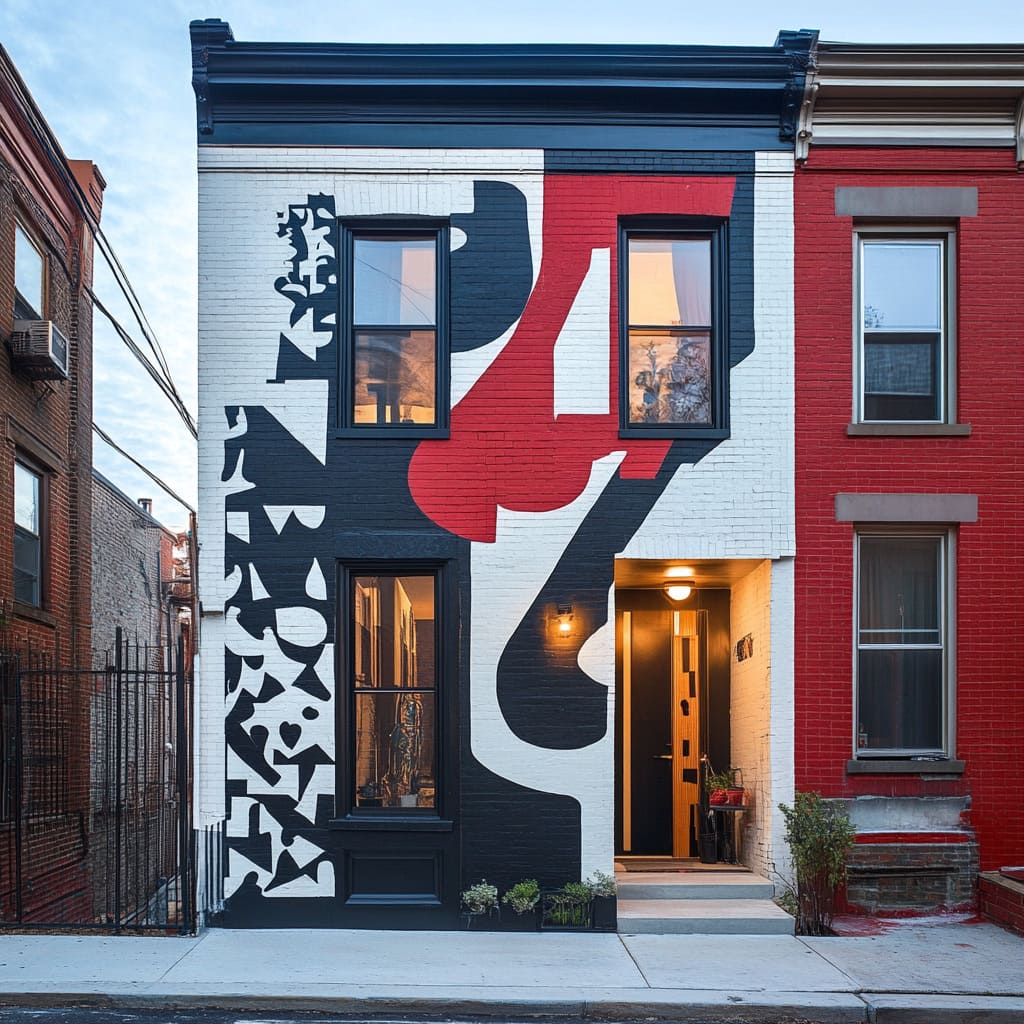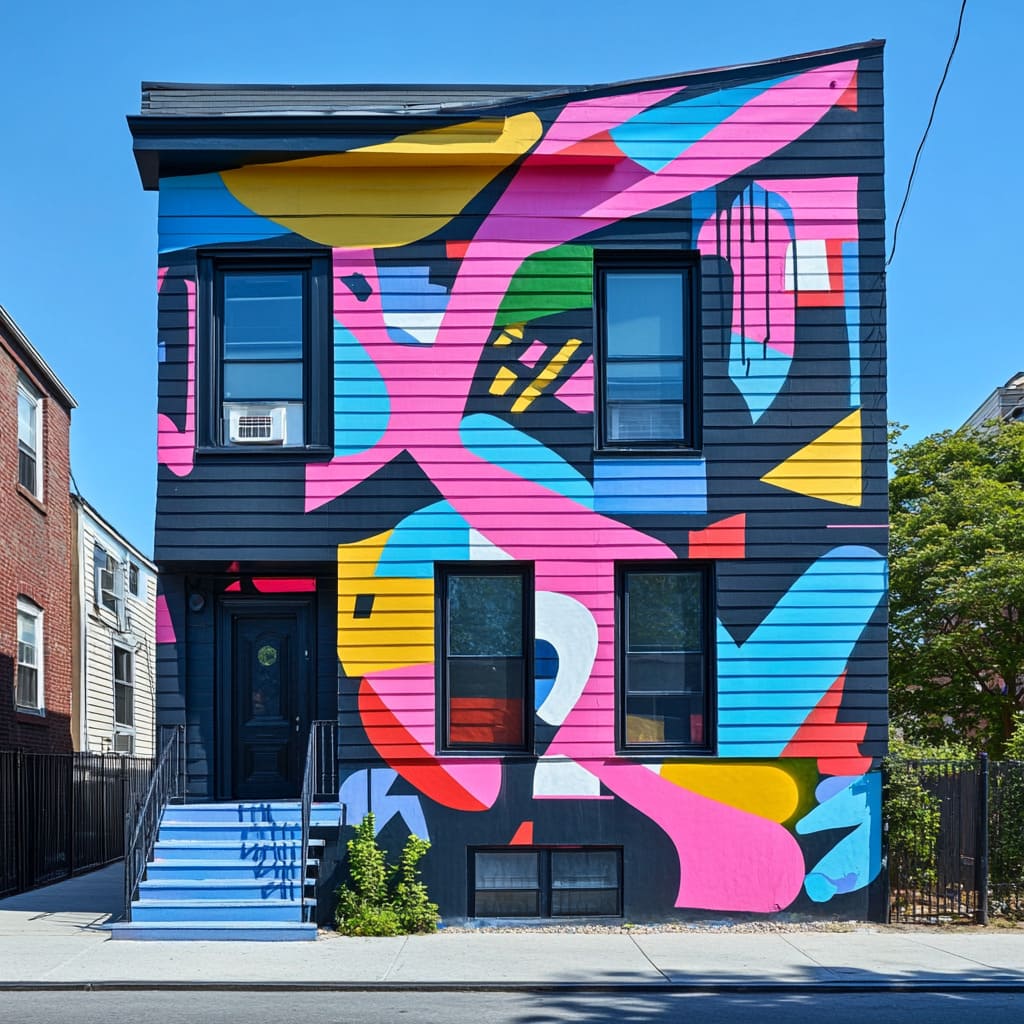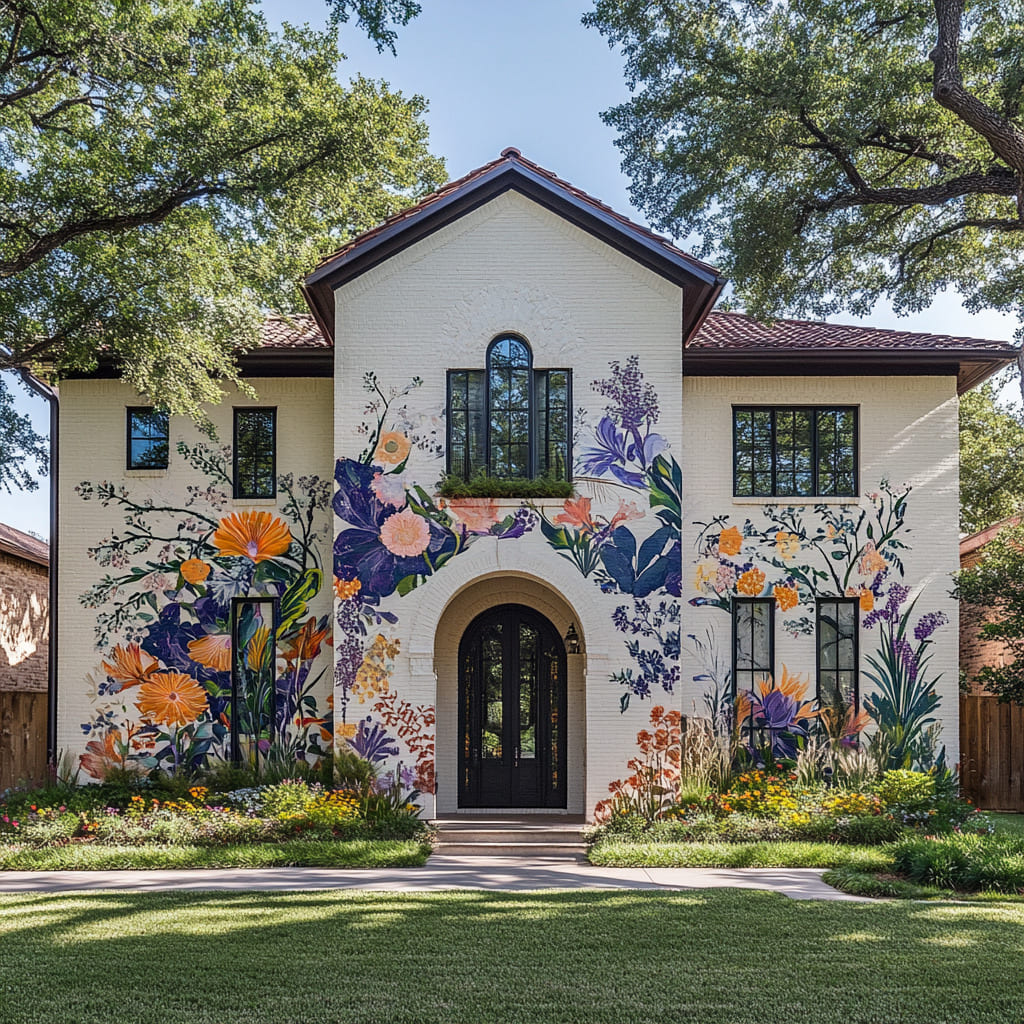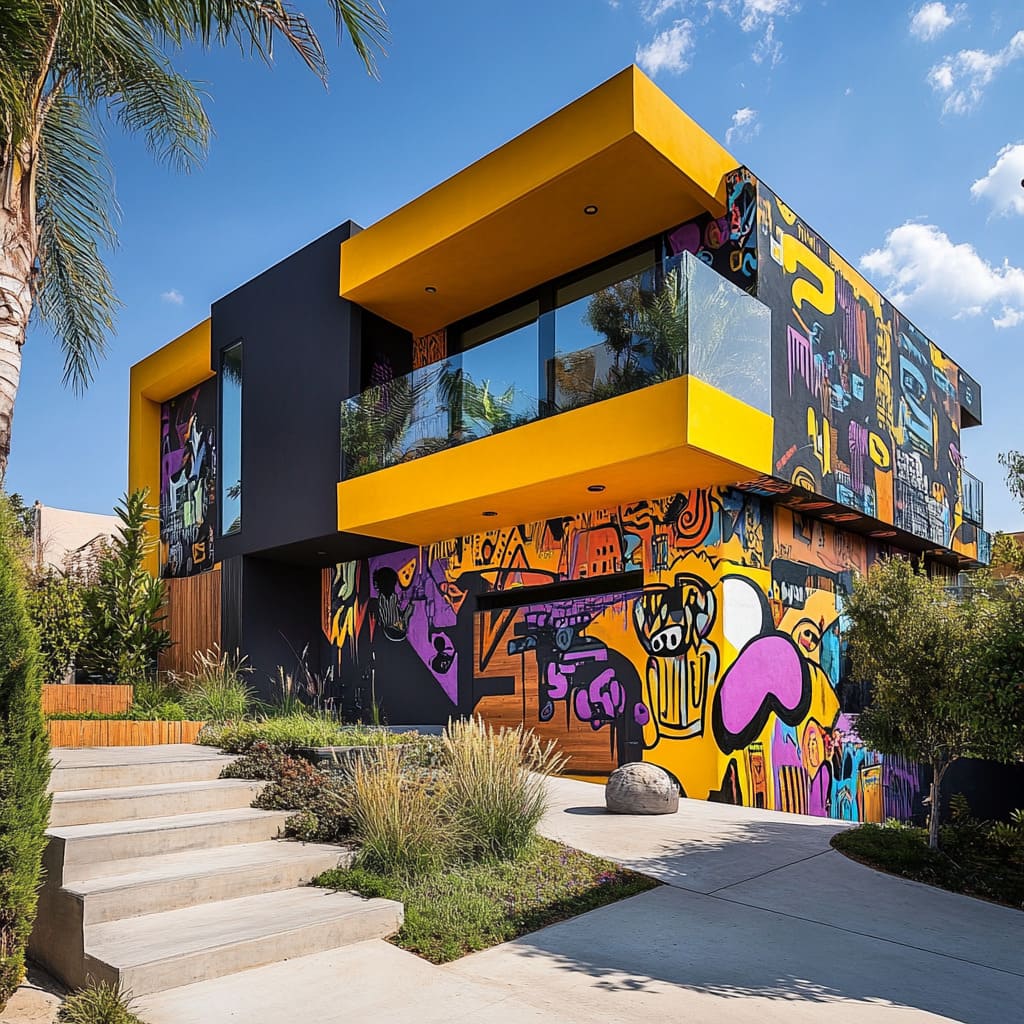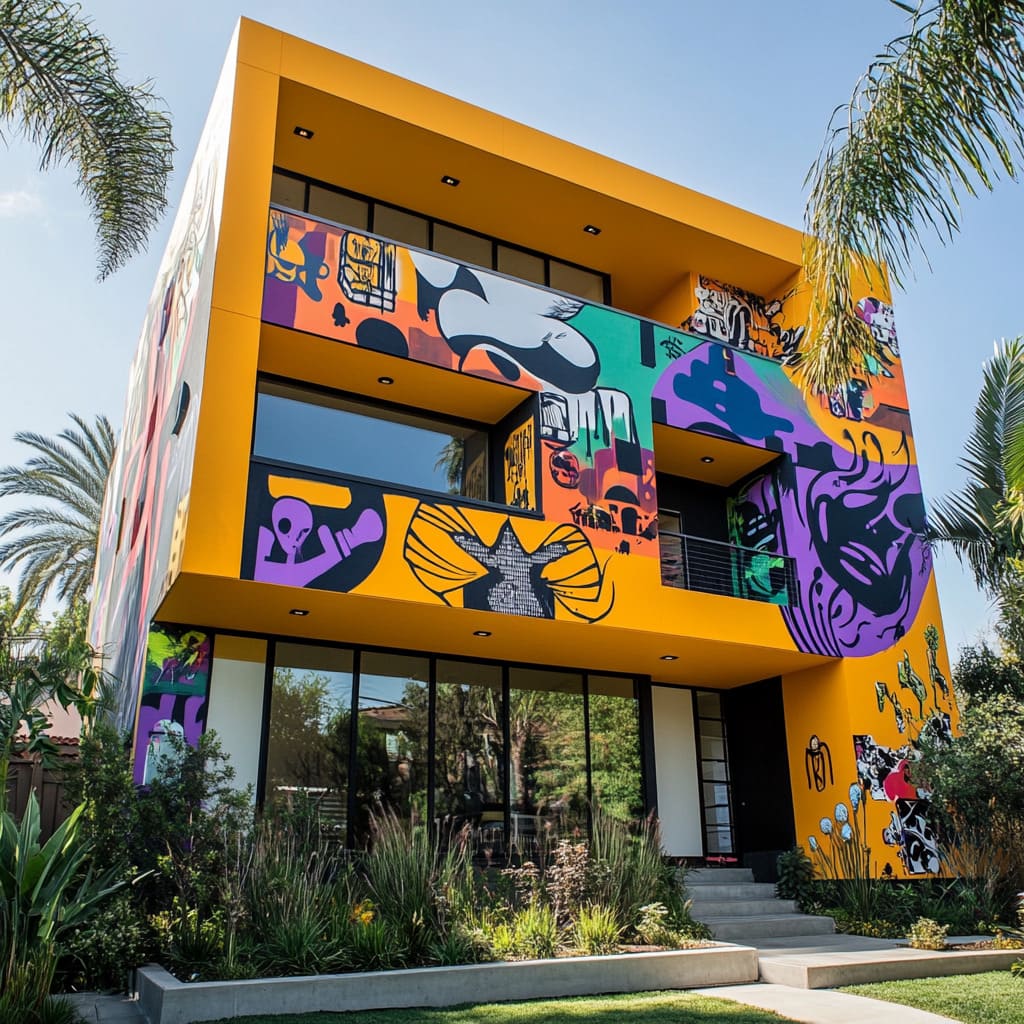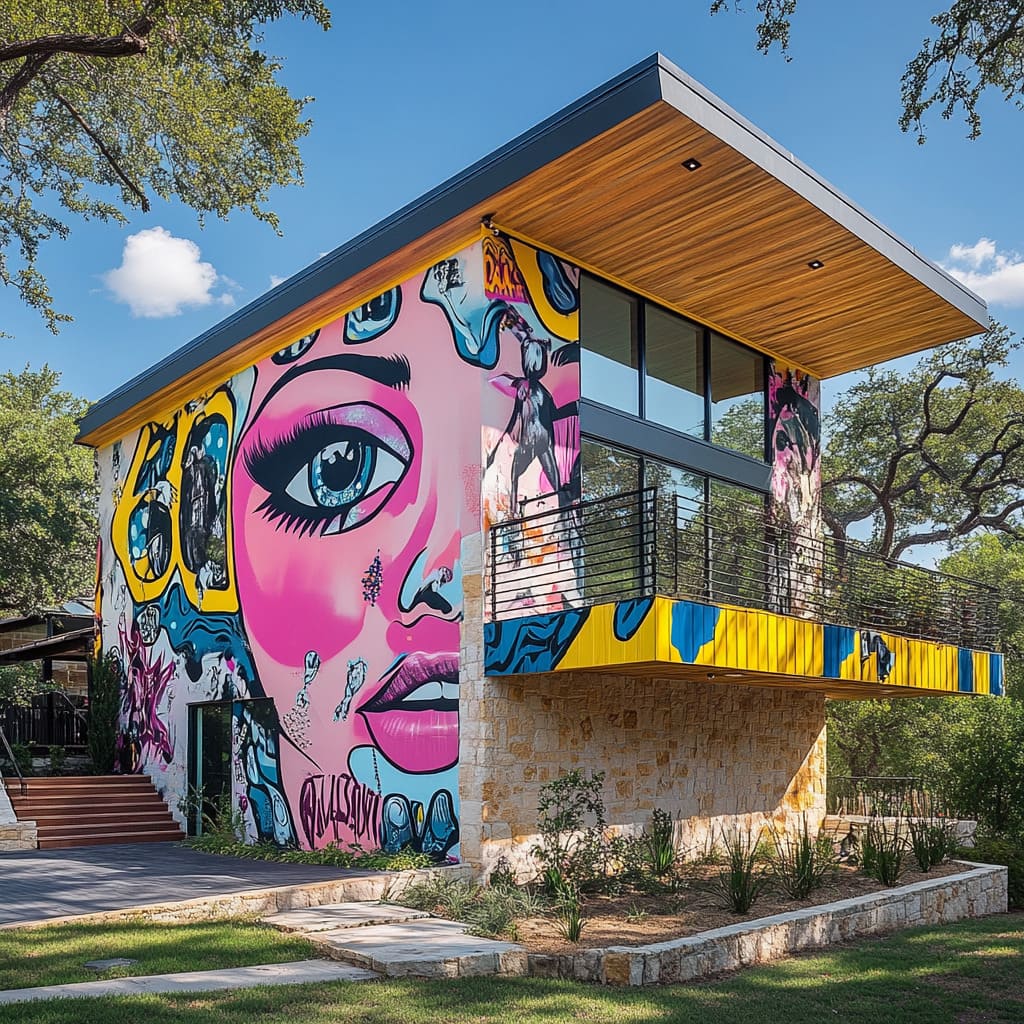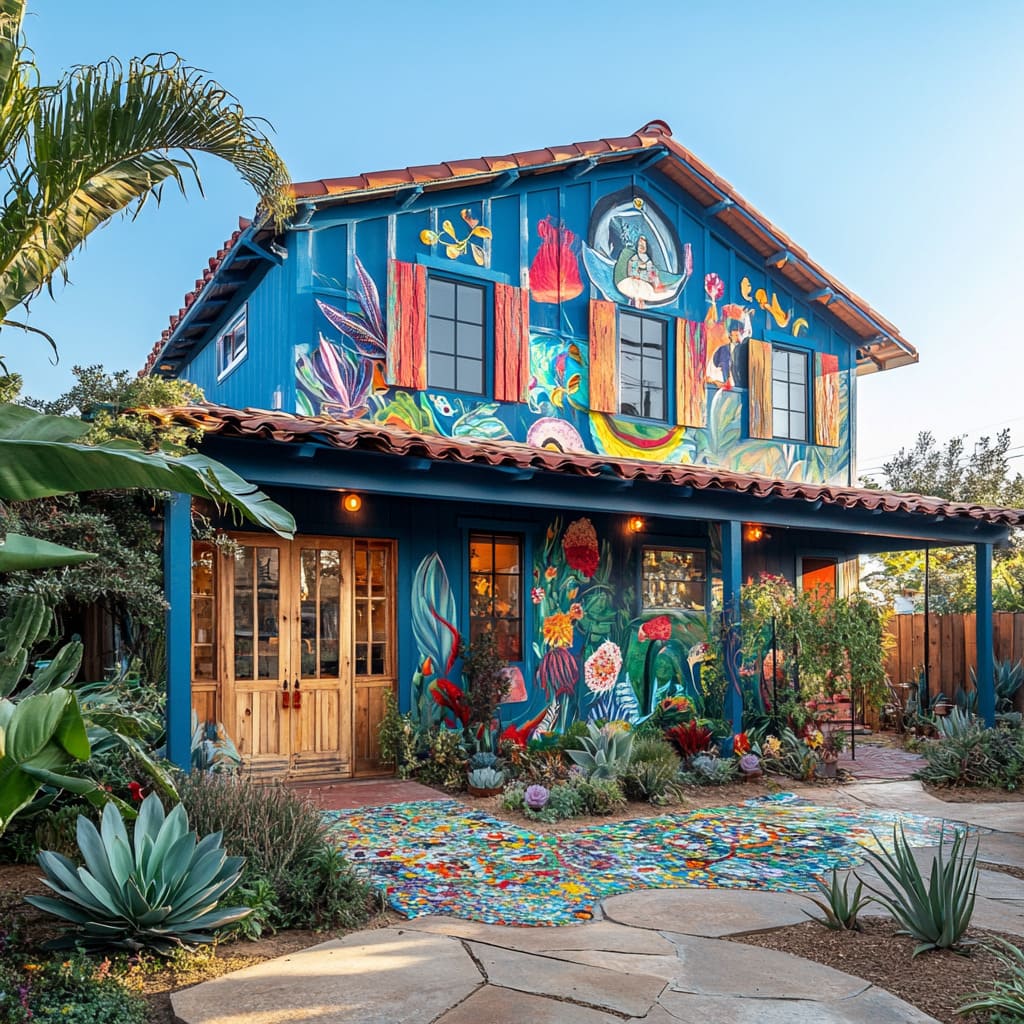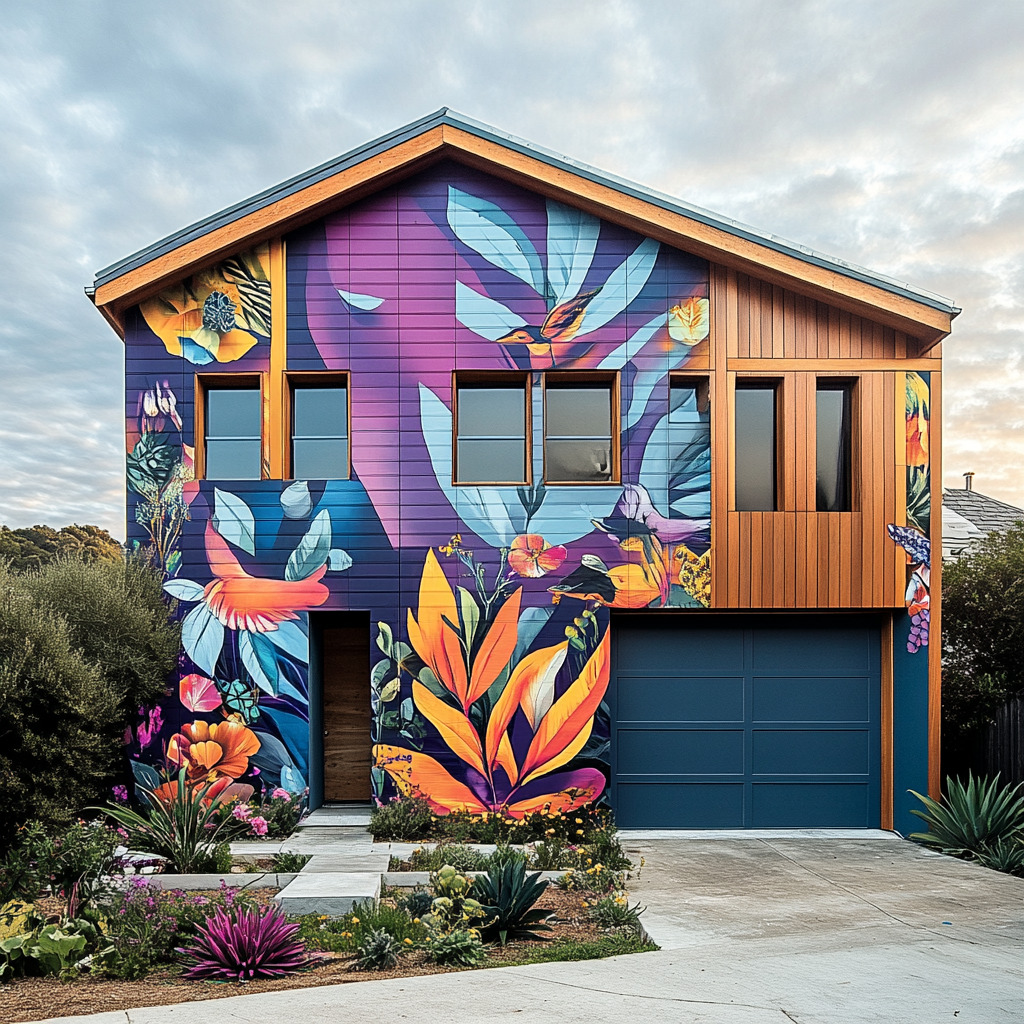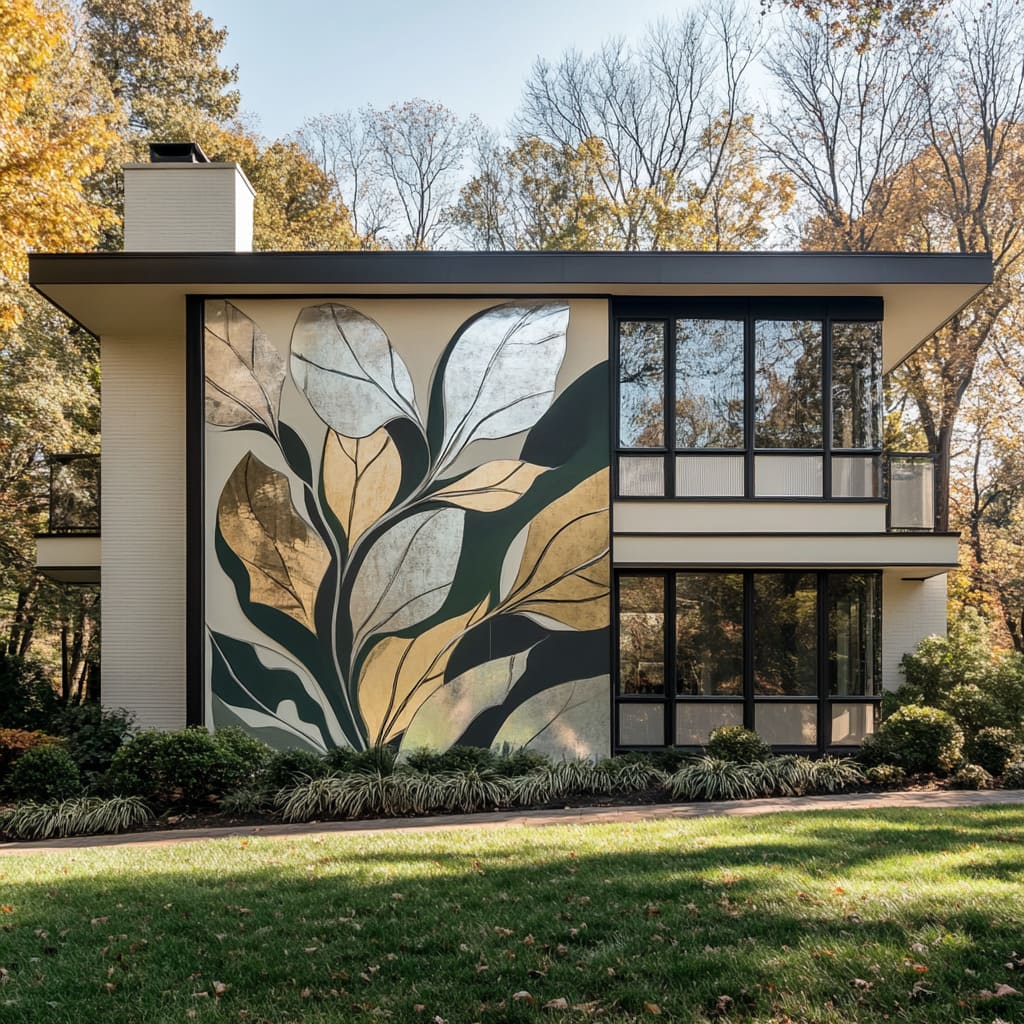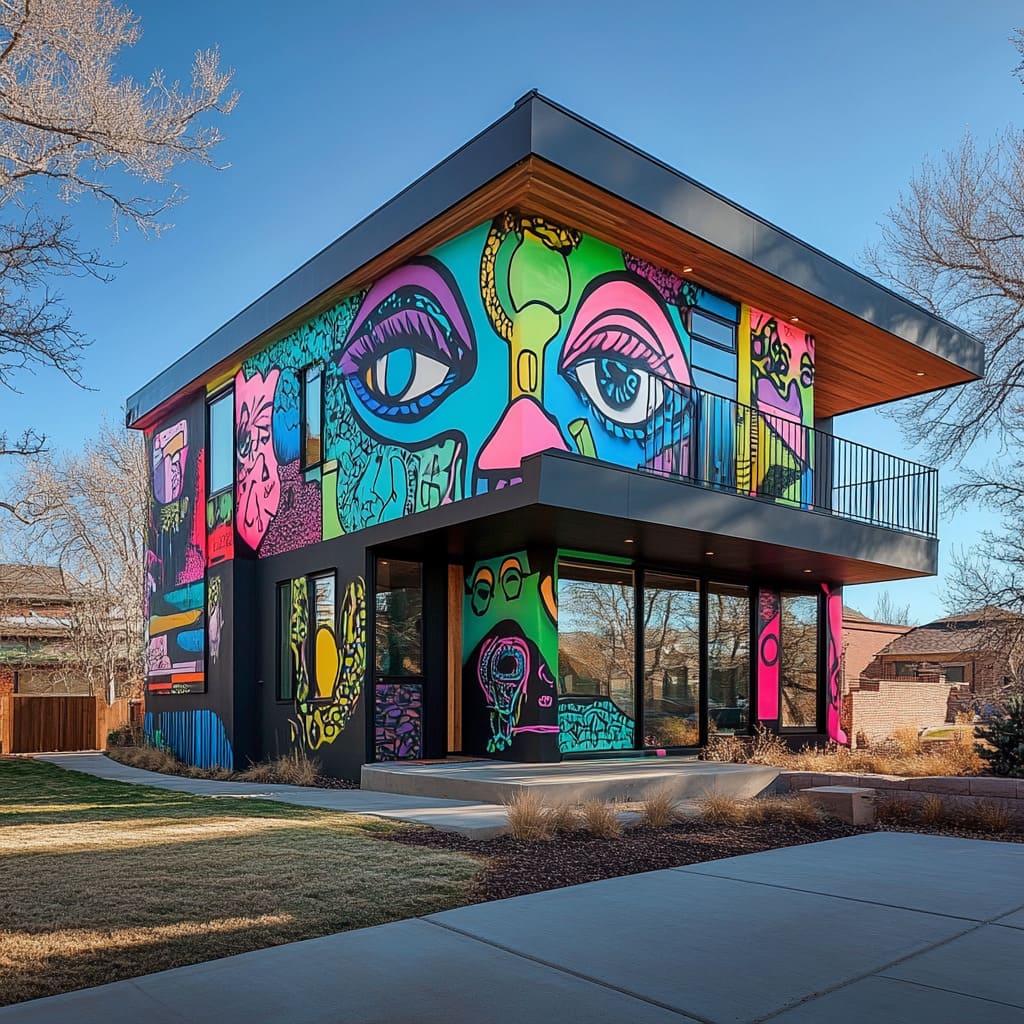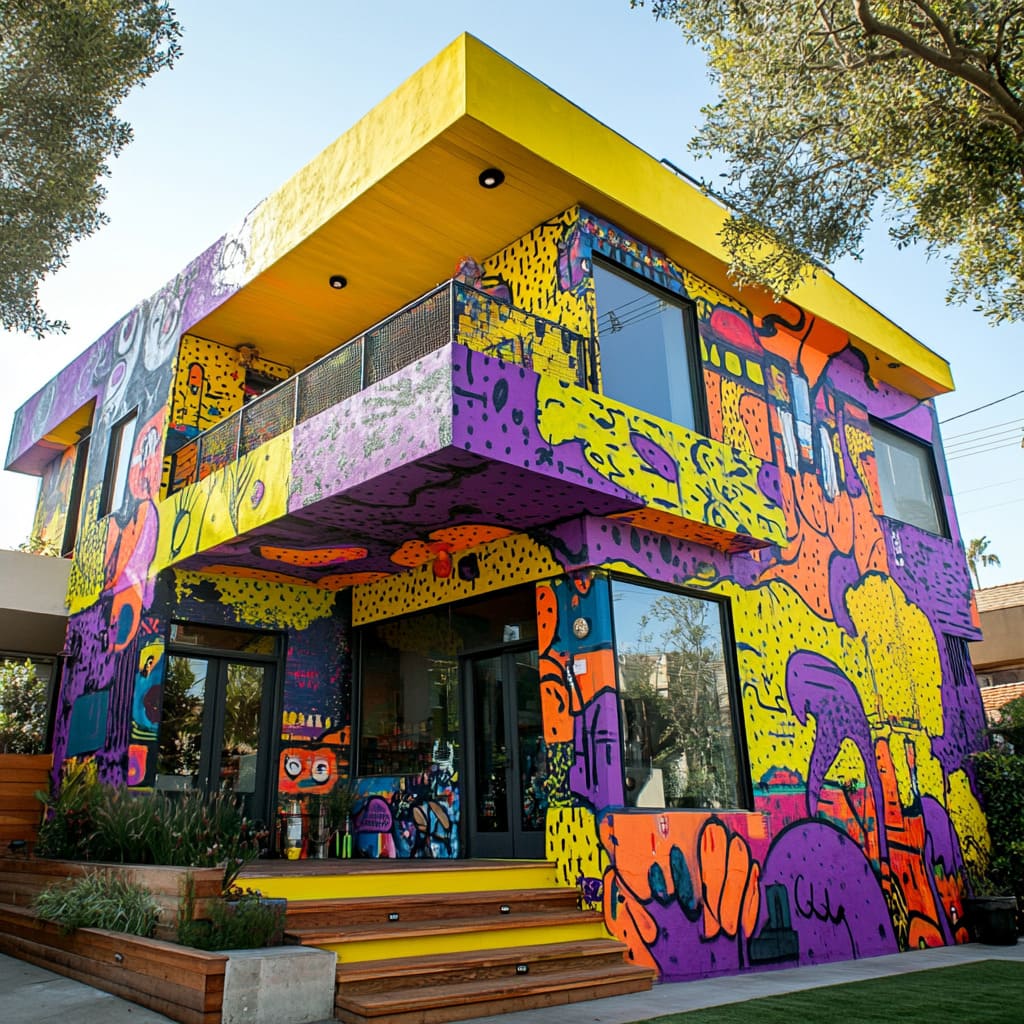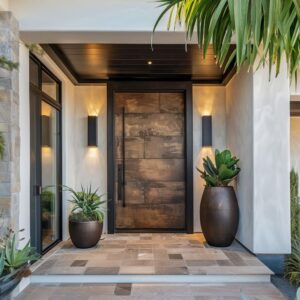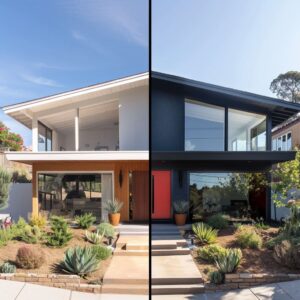Imagine strolling through a quiet neighborhood of classic suburban homes—red-brick facades, neat lawns, and all the hallmarks of traditional architecture. Suddenly, you turn a corner and find yourself face-to-face with a house unlike any other on the block.
Its once-ordinary exterior is now covered in a stunning mural: vibrant colors swirl across the walls, depicting a scene that is both mesmerizing and unexpected. Passersby pause to take it all in, snapping photos, and sharing smiles.
This house, once just another building on a quiet street, has become a local landmark, a conversation starter, and a source of inspiration. This is the transformative power of murals—turning the mundane into something remarkable.
Over recent years, a growing trend has emerged that breathes new life into residential areas: the use of bold, colorful murals on home exteriors. No longer confined to commercial buildings or public spaces, these large-scale artworks are making their way into neighborhoods, adding a burst of creativity and character to traditional home architecture.
Homeowners are increasingly drawn to the idea of murals as a means to revitalize their properties, transforming plain facades into vibrant works of art. Beyond their aesthetic appeal, murals also foster a sense of community engagement, sparking conversations and bringing neighbors together
From Ordinary to Extraordinary: The Power of Murals
Murals have a unique ability to elevate the look and feel of a home. When a mural is added to a home’s exterior, it doesn’t just alter the color or pattern; it reshapes the entire personality of the house.
A plain brick wall becomes a canvas for a lush, botanical scene, or a bland siding is reimagined with bold geometric shapes that play with light and shadow. This kind of transformation can change how a house is perceived and experienced, turning what was once a simple structure into a dynamic piece of art.
Consider the example of a two-story home in a suburban area, which originally featured a standard white facade with a few decorative trims. With the addition of a mural—a swirling abstract design in vivid blues and oranges—this home underwent a radical transformation.
The swirling lines draw the eye upward, creating a sense of height and movement, while the colors contrast beautifully with the surrounding greenery. Neighbors who had walked by this house daily without a second glance suddenly found themselves captivated by its new look.
The home, now visually striking, became a focal point in the neighborhood, showcasing how a well-placed mural can transform a traditional facade into an extraordinary visual experience
Creating Neighborhood Landmarks
Beyond individual homes, murals have the power to redefine entire neighborhoods. When a homeowner decides to add a mural, they often unknowingly set off a chain reaction.
Other residents take notice; some are inspired, and soon enough, more homes begin to adopt similar artistic enhancements. This phenomenon can transform a quiet residential street into a vibrant gallery, attracting visitors and fostering a sense of pride among residents.
Take, for instance, the story of a house in a creative suburb of a bustling city. The home, once a nondescript brick building, was transformed with a large-scale mural featuring an abstract floral theme.
The mural, with its cascading petals in bright purples and greens, immediately caught the attention of the community. People began to gather around the house, admiring the artwork and discussing its impact.
Local social media lit up with images of the mural, and soon enough, the house became a destination. It wasn’t just the owners who were proud; the whole neighborhood felt a sense of ownership and excitement over their new landmark.
This is the magic of murals—they can turn an ordinary home into a beloved point of interest, enhancing not just the property’s value but also the cultural fabric of the area
Strategic Design: Merging Murals with Architecture
A mural is more than just a painting on a wall; it’s a thoughtful integration with the architectural elements of the home. Skilled muralists know how to use the structure of a building to their advantage, incorporating windows, doors, and rooflines into the design to create a seamless and engaging visual flow.
A mural might use the vertical lines of a home’s siding to suggest the stems of flowers or follow the curves of an arched doorway to frame a central motif.
For example, consider a home with a traditional bay window. Instead of painting around it, an artist might use the window as the center of a radiant sunburst design, with rays extending outward across the facade.
This approach not only enhances the architectural feature but also integrates it into the mural, making the window an active part of the artwork. Another example could be a mural that wraps around a corner, using the edge of the building to create a sense of depth and continuity that draws the viewer’s eye along the facade.
By thoughtfully incorporating architectural elements, murals become more than just surface decoration; they transform the entire structure into a cohesive piece of art
Using Murals to Enhance Visual Flow
Strategic placement is key to a mural’s impact. A well-designed mural doesn’t just sit on a wall; it moves with it, guiding the viewer’s gaze across the building in a deliberate and captivating way.
Artists often use techniques like layering, shading, and perspective to create a sense of depth and movement. This dynamic quality not only makes the mural more engaging but also enhances the architectural form of the house.
One technique involves placing elements of the mural—such as large leaves or abstract shapes—so that they appear to ‘grow’ from one side of the house to the other, encouraging viewers to move around and view the home from different angles. This creates an interactive experience, where the house itself seems to change and evolve depending on where you stand.
In another instance, a mural might use a gradient of colors that flows from dark to light, drawing the eye upward and creating a sense of elevation and grandeur. These design strategies do more than beautify a building; they actively engage the viewer, transforming the way a house is seen and experienced.
Choosing Colors: Bold Palettes and Emotional Impact
Making a Statement with Color
Color is one of the most powerful tools in a muralist’s arsenal. The right color palette can completely change the mood of a house, creating a specific atmosphere that resonates with the homeowner and the community.
Vibrant hues can evoke feelings of joy, energy, and warmth, while softer tones can create a sense of calm and tranquility
For instance, a mural with a palette of bright yellows, reds, and oranges can evoke a feeling of warmth and vibrancy, making a house appear more welcoming and alive. On the other hand, a mural that incorporates cool blues, greens, and purples can create a soothing, tranquil atmosphere that complements a home’s natural surroundings.
The choice of colors is not just about aesthetics; it’s about creating an emotional connection. The use of bold, unexpected colors can also challenge conventional notions of what a home should look like, encouraging both the residents and their neighbors to think differently about their environment
Achieving Harmony with Bold Contrasts
While color can create mood and atmosphere, it can also be used to achieve balance and harmony with a home’s existing exterior. A skilled artist knows how to use color to either complement or contrast with the house’s original tones, achieving a look that feels both fresh and cohesive.
For example, a home with a neutral, beige exterior might be revitalized with a mural featuring deep blues and greens, creating a calming effect that blends seamlessly with the natural landscape. Conversely, a home with a darker, more muted facade might benefit from a mural with bright, contrasting colors like hot pinks and oranges, creating a vibrant, eye-catching contrast that adds depth and excitement.
By carefully selecting colors that either harmonize with or stand out against the home’s original palette, a mural can change not just the appearance of a house, but the way it is perceived and experienced by all who see it. By thoughtfully integrating colors, designs, and architectural features, murals have the power to transform the traditional home into something extraordinary, creating unique, personalized spaces that reflect the personality and style of their owners.
This trend not only enhances individual properties but also enriches the entire community, turning ordinary streets into vibrant galleries that celebrate creativity and expression
Styles and Themes: From Abstract to Nature-Inspired
Abstract and Geometric Designs
Abstract and geometric designs are becoming increasingly popular choices for homeowners looking to transform their exteriors with a modern touch. These murals often feature bold shapes, striking lines, and vibrant colors that breathe life into otherwise straightforward facades.
For a modern, some homeowners are opting for murals that incorporate infographic style designs. These can display anything from family history timelines to botanical charts, blending visual appeal with educational content.
The appeal of abstract art lies in its ability to evoke emotion and provoke thought without adhering to traditional forms or subjects. For many homeowners, this style offers a way to make a unique statement, turning their homes into standout pieces within their neighborhoods.
Consider a home from the examples discussed earlier in the chat. One house featured a mural composed of sweeping geometric shapes in hues of purple, orange, and blue.
The design wraps around the building, creating a sense of movement and flow. These bold patterns interact dynamically with the house’s architectural lines, playing off the angles of the roof and the sharp edges of window frames.
The result is a facade that feels both grounded and fluid, as if the house itself is shifting and changing before your eyes. The use of bold geometric shapes transforms the building into a piece of contemporary art, making it a focal point in the neighborhood
Another example showcased an abstract mural with large, colorful forms that seem to leap off the walls. This design utilized overlapping shapes and contrasting colors to create a sense of depth and dimension.
The abstract forms softened the building’s rigid architecture, giving it a more fluid and dynamic appearance. This transformation illustrates how abstract art can be more than just decorative—it can redefine the visual identity of a home, blending modern flair with the existing structure in unexpected ways
Nature and Botanical Motifs
While abstract designs offer a modern twist, nature-inspired murals provide a softer, more organic alternative that can beautifully complement both traditional and contemporary homes. Botanical themes—featuring flowers, leaves, and other elements of nature—are especially popular for homeowners looking to create a more welcoming and tranquil environment.
These murals often draw from a palette of greens, pinks, yellows, and blues, bringing a sense of the outdoors directly onto the home’s exterior.
One striking example from the chat involves a home enveloped in a mural of cascading flowers and foliage. This botanical motif, with its detailed renderings of roses, lilies, and vines, not only enhances the building’s facade but also blurs the line between the home and its natural surroundings.
The mural softens the architectural lines, turning hard edges into gentle curves and rigid surfaces into flowing forms. This creates a seamless blend of the built environment and nature, providing a serene escape within an urban setting
Botanical murals also have the power to evoke a sense of nostalgia and comfort. For instance, a mural featuring vibrant florals against a backdrop of soft greens and blues can evoke memories of a garden in full bloom, adding a layer of warmth and character to a home.
These themes are particularly effective in urban environments, where concrete and steel dominate. By bringing elements of nature onto the walls, homeowners can create a calming retreat that feels both intimate and expansive.
Technical Aspects: Materials, Textures, and Durability
Selecting the Right Materials
When considering a mural for a home’s exterior, the choice of materials is crucial for ensuring both aesthetic appeal and longevity. The type of paint, surface preparation, and underlying material all play a role in how well a mural will withstand the elements.
Weather-resistant paints, for example, are essential to prevent fading and peeling over time. These paints are specifically formulated to endure sunlight, rain, and temperature fluctuations, maintaining their vibrancy and adhesion
Different surfaces also interact with murals in unique ways. A brick facade offers a textured background that can add depth to a mural, but it requires careful preparation to ensure the paint adheres properly.
Stucco, with its rough texture, can create a dramatic effect, but it also demands specific types of paint that can flex with the surface. Wood siding, meanwhile, provides a smoother canvas but may need extra sealing to prevent moisture penetration and warping.
Choosing the right materials is about more than just durability—it’s also about enhancing the artwork itself. The natural grain of wood or the rugged texture of brick can be incorporated into the mural’s design, adding layers of complexity and interest.
These textural elements can turn a simple painting into a multi-dimensional experience, drawing viewers closer to explore the intricate interplay between the artwork and its canvas
Enhancing Texture and Depth
The existing texture of a building’s exterior can greatly influence the final look of a mural. Artists often use these textures to their advantage, employing techniques that enhance or play off the natural surfaces.
For example, a rough brick wall might be used to create a sense of ruggedness in a landscape mural, while a smooth wooden siding might serve as a perfect backdrop for delicate, intricate designs
To enhance depth, artists may use shading techniques that mimic natural light and shadow, giving the illusion that elements of the mural are popping out from the surface. This can make the artwork feel more alive and engaging, transforming a flat facade into a vibrant, three-dimensional canvas.
Techniques like trompe-l’œil—where the artist creates a realistic image that tricks the eye into perceiving depth—are particularly effective on flat, expansive surfaces. Incorporating the texture of the building material into the mural can also add an element of surprise.
The natural grooves of stucco or the gaps in brickwork can be used to create unexpected visual effects, such as the appearance of creeping vines or cracks in a painted stone wall. These elements add a layer of realism and interest, making the mural a true extension of the home’s architecture
Lighting and Murals: Creating Magic After Dark
Lighting plays a significant role in bringing a mural to life, particularly after the sun goes down. Strategic lighting can highlight key elements of a mural, enhancing its visibility and impact.
Soft ambient lighting can wash over the entire mural, creating a gentle glow that makes the colors pop even in low light. Spotlights can be used to focus on specific areas of the mural, drawing attention to particular details or creating dramatic contrasts between light and shadow.
For instance, a mural featuring a botanical theme might benefit from uplighting that highlights the painted flowers and foliage, casting shadows that mimic the natural play of moonlight on a garden. This technique can create a serene and magical atmosphere, making the mural a focal point not just during the day, but also at night.
Playing with Light and Shadow
The interplay of light and shadow can dramatically change the perception of a mural, creating a dynamic experience that shifts with the time of day and the quality of light. During the day, natural sunlight might cast strong shadows that enhance the depth of a mural, making it appear more three-dimensional.
At night, strategically placed lights can cast new shadows or highlight different elements, transforming the mural’s appearance and giving it a completely new character. Consider a mural with abstract geometric shapes.
During the day, the sun might highlight certain angles and colors, creating a sharp, vibrant effect. As the day progresses and the light changes, the mural’s appearance shifts, with different elements coming to the forefront.
At night, a well-placed spotlight can accentuate certain shapes or colors, creating a new focal point and adding layers of complexity and intrigue.
Integrating Murals with Landscaping and Surroundings
A mural on a home’s exterior is like an open invitation to think creatively about the surrounding landscape. Just as the mural itself transforms the building’s appearance, the landscape around it can play a pivotal role in enhancing and complementing the mural’s themes and colors.
The idea is to extend the mural’s visual impact beyond the walls, creating a harmonious blend between painted art and natural elements
To achieve this, homeowners and landscape designers often select plants, flowers, and shrubs that echo the colors and motifs of the mural. For example, if the mural features a palette dominated by purples, blues, and greens with images of wildflowers, the garden could include lavender, blue salvia, and ferns to reflect these hues and shapes.
These choices create a visual flow from the garden to the mural, making the entire property feel like a single, cohesive piece of art. Plant arrangements can also be designed to mirror the structure and movement found in the mural.
For instance, a mural with upward-reaching lines or abstract forms might be paired with tall, slender plants like ornamental grasses or bamboo, which mimic these vertical elements. On the other hand, a mural with more fluid, sweeping designs could be complemented by the curved forms of hostas or hydrangea bushes.
The choice of plants and their placement can create a dynamic interplay between the mural and its surroundings, enhancing the overall aesthetic and inviting viewers to explore the space from multiple angles.
Hardscape elements, such as pathways, retaining walls, and garden sculptures, can also be chosen to complement the mural. Materials like stone, brick, or metal can either match the tones in the mural or provide a contrasting texture that makes the artwork stand out even more.
A pathway leading up to a house with a geometric mural might be designed with angular stepping stones, reinforcing the mural’s modern aesthetic. Meanwhile, softer, curved pathways could echo the flowing lines of a more organic mural, creating a sense of continuity between the garden and the mural.
Mural and Nature Fusion
Achieving a seamless blend between painted and natural elements takes careful planning and a bit of artistic vision. The goal is not to have a clear boundary where the mural ends and nature begins, but rather to blur that line, creating a fluid transition that makes the mural feel like an organic extension of the landscape.
One strategy is to use climbing plants and vines to connect the mural to the garden physically. For instance, ivy or climbing roses can be planted near the base of the mural, allowing them to grow up and around the painted elements.
Over time, these plants can merge with the mural, adding a layer of texture and depth that enhances the artwork’s impact. The interplay of real and painted foliage can create a striking effect, where it’s hard to tell where the paint stops, and the plant begins
Another approach is to use water features like ponds or fountains that reflect the mural, creating a mirrored image that doubles the visual impact. This technique is especially effective with murals that include elements of water, sky, or open spaces.
A small pond placed strategically in front of a mural can reflect its colors and shapes, creating a dynamic, living artwork that changes with the light and weather. Natural elements, such as rocks, pebbles, or wood, can also be incorporated into the landscape to echo the textures found in the mural.
A mural depicting a forest scene, for instance, could be complemented by a garden path made of rough-cut stones or a seating area surrounded by driftwood sculptures. These elements reinforce the mural’s theme and create a sense of immersion, making the viewer feel as though they are stepping into the scene itself
Murals as Cultural Narratives and Community Engagement
Murals are more than just decorative—they can tell stories, reflect cultural heritage, or convey a community’s values. In residential settings, these large-scale artworks often become narrative devices that engage both the homeowner and the community.
By choosing a specific theme or motif, homeowners can use murals to express personal histories, family traditions, or cultural pride. For example, a mural on a home in a historically significant neighborhood might feature elements that reflect that area’s cultural heritage—a tribute to local folklore, historical events, or prominent figures.
This approach not only personalizes the home but also educates and engages visitors, turning the mural into a conversation starter. Residents and visitors alike are drawn in, learning more about the area’s history and the stories it holds.
In another case, a homeowner might commission a mural that reflects a personal journey or a significant life event, such as a marriage or a birth. This kind of mural transforms the exterior of a home into a public yet intimate canvas, sharing a personal narrative in a way that invites curiosity and connection.
People passing by can feel a sense of connection to the story being told, enhancing the community’s social fabric.
Murals and Community Identity
Murals have a unique ability to contribute to a neighborhood’s sense of place and identity. When several homes in a community adopt murals, a subtle transformation begins.
The neighborhood starts to feel more cohesive, united by a shared appreciation for art and expression. These murals often become symbols of community pride, reflecting the collective spirit of the area.
Community-driven mural projects, in particular, have a profound impact. When neighbors come together to plan and execute a mural, the process fosters collaboration and communication.
These projects often reflect shared values or concerns, whether they are about celebrating diversity, promoting sustainability, or honoring local history. Once completed, these murals serve as tangible reminders of what the community stands for, strengthening bonds among residents and enhancing the neighborhood’s character.
There are countless stories of neighborhoods that have embraced murals as part of their identity. In some cases, these artworks have even attracted visitors and tourists, turning quiet residential streets into lively cultural destinations.
The murals, with their bold statements and vibrant colors, become more than just artwork—they become ambassadors for the community, showcasing its uniqueness and inviting others to appreciate it
Beyond Aesthetics: The Functional Benefits of Murals
Protection and Preservation
While the aesthetic appeal of murals is often the primary reason for their installation, they also offer several practical benefits. One of the less obvious advantages of a mural is its ability to protect the underlying surfaces from the elements.
A mural acts as an additional layer of protection against weathering, shielding the exterior walls from sun exposure, rain, and wind. High-quality, weather-resistant paints can help seal surfaces, preventing moisture from penetrating and causing damage such as cracking or peeling
For homes in harsh climates, this protective layer can significantly extend the life of the exterior materials. In regions prone to heavy rains or intense sunlight, a well-maintained mural can help prevent the kind of wear and tear that would otherwise lead to costly repairs.
This dual function—beautifying a home while preserving its structural integrity—makes murals a wise investment for homeowners
Enhancing Property Value
Murals can also have a positive impact on a home’s market value. A striking mural can significantly increase curb appeal, making the property more attractive to potential buyers.
Real estate experts often talk about the importance of first impressions, and a well-executed mural can make a home stand out in a competitive market. A unique, visually appealing exterior can draw in buyers who might not have considered the property otherwise, especially those looking for a home with character and personality
Case studies from various cities have shown that homes with distinctive murals often receive more attention on the market and can command higher prices. Potential buyers are drawn to the idea of owning a home that is also a piece of art, something that sets it apart from the rest.
A mural can turn a generic house into a one-of-a-kind property, enhancing its value and appeal
Conclusion
Murals have the power to transform not just the appearance of a home, but its entire presence within a neighborhood. They reflect personal expression, tell stories, and foster a sense of community.
Beyond their visual appeal, murals offer functional benefits that make them a valuable addition to any home. By blending art with architecture, homeowners can create spaces that are both beautiful and meaningful, enriching the lives of those who see them every day.
As more people recognize the transformative potential of murals, neighborhoods around the world are becoming more colorful, vibrant, and connected, one mural at a time.

